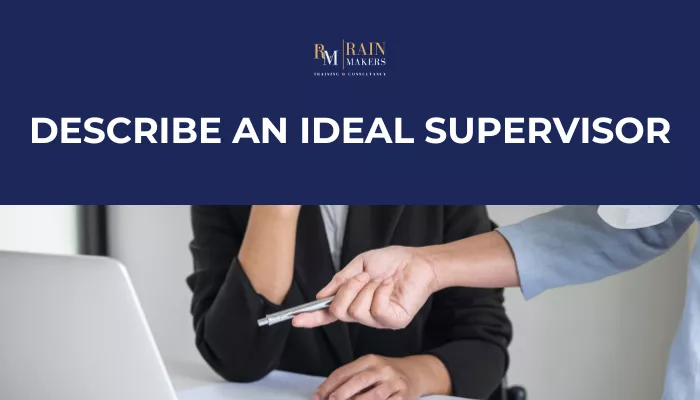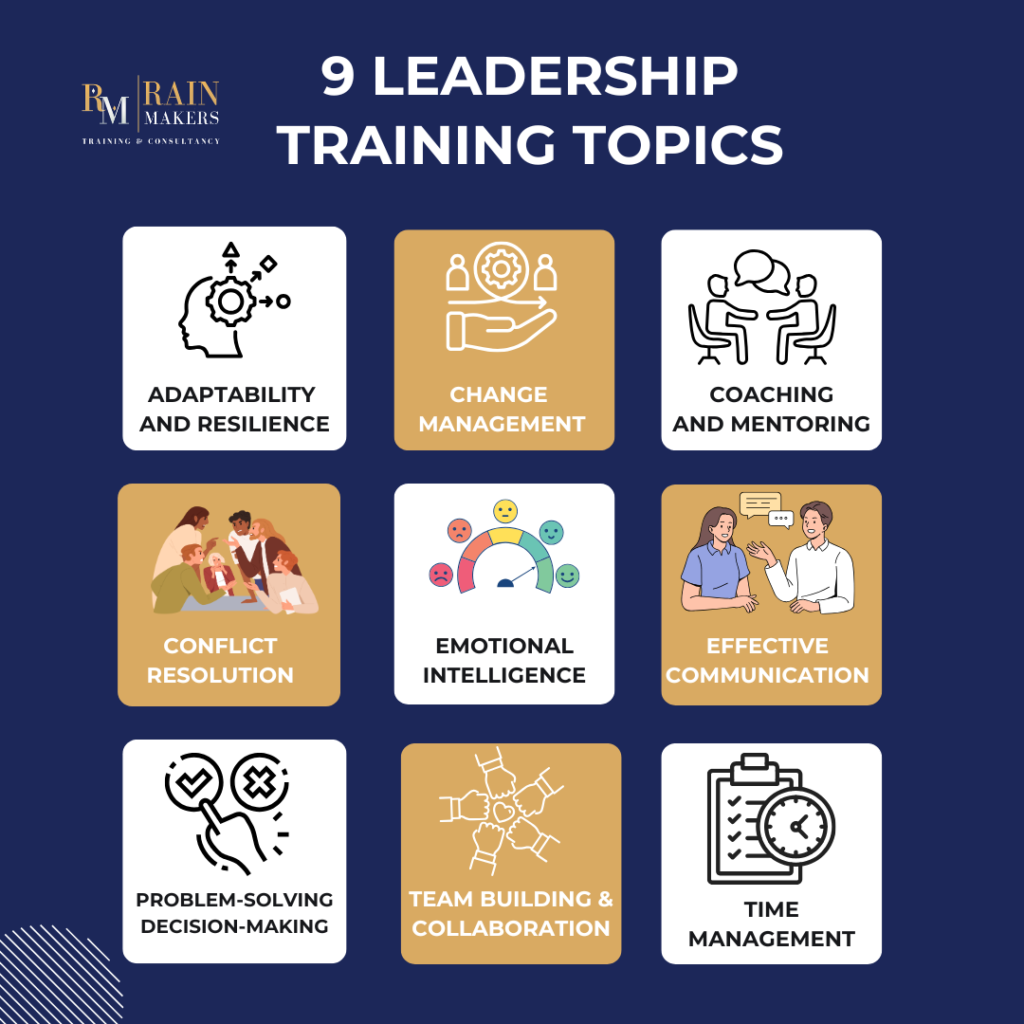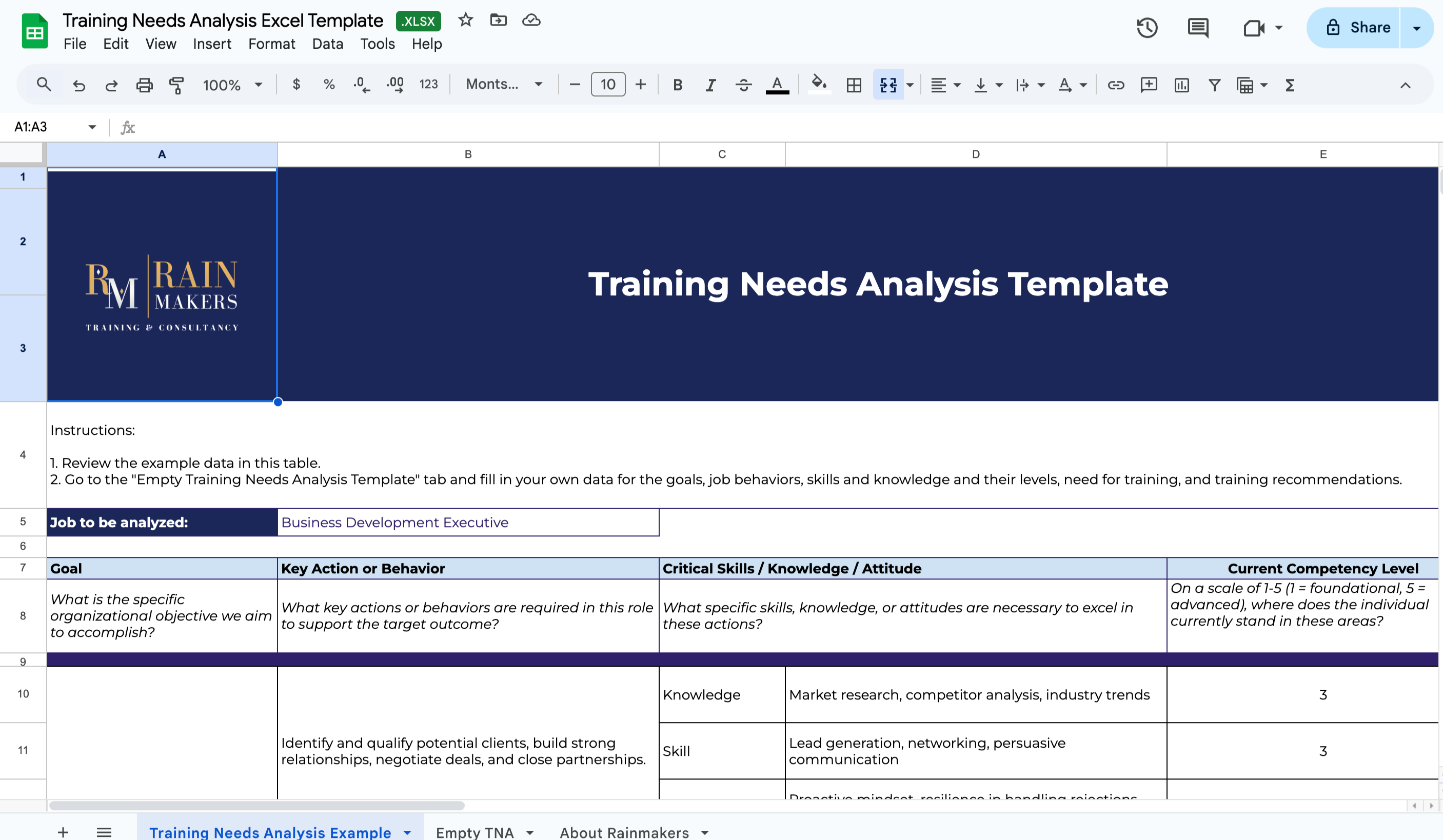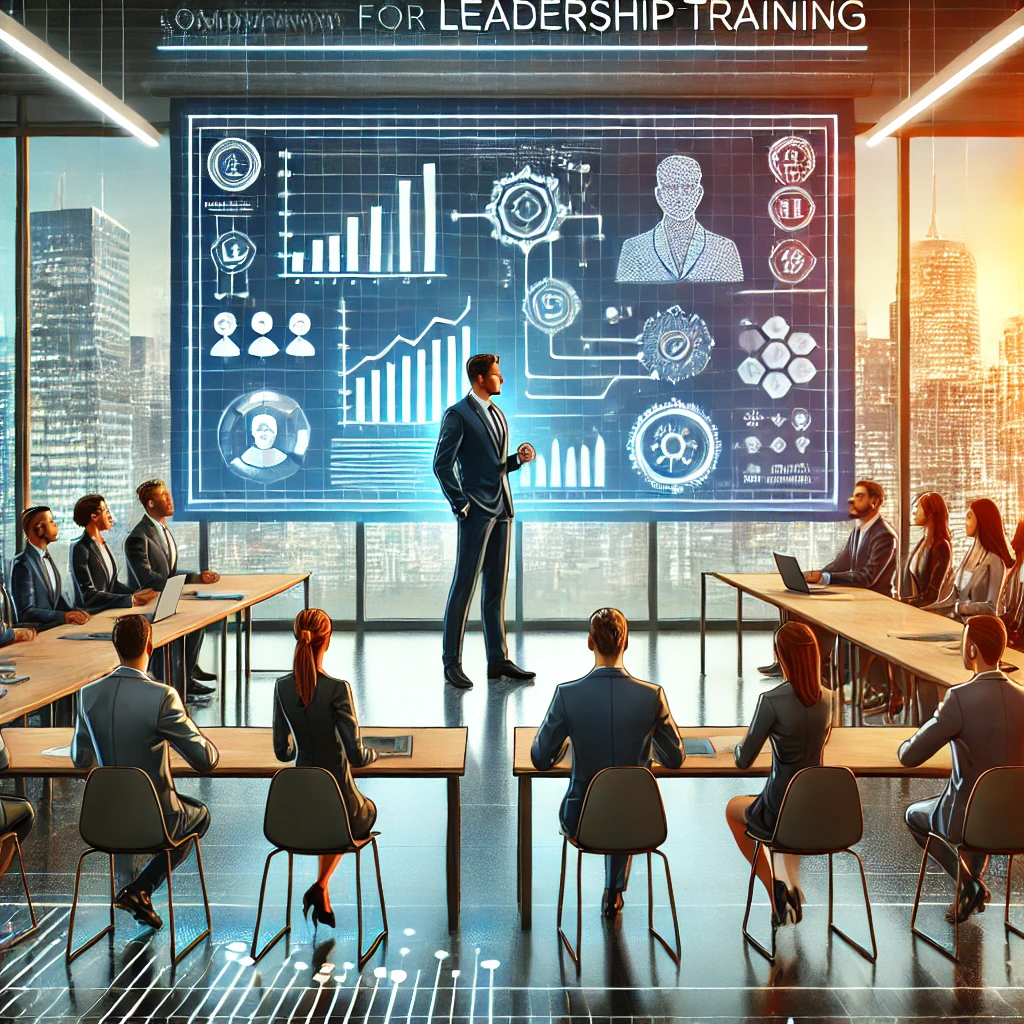Best Leadership Training Providers in the Philippines [2025]
With many training options available, choosing the right leadership training provider can be difficult.
To help you decide, we handpicked the best leadership training providers in the Philippines. These training companies offer structured programs, practical tools, and real-world insights to build strong leaders at every level, from supervisors to senior executives.
1. Rainmakers Training and Consultancy
Core Strengths: Leading Gen Z and Millennials, Basic Leadership and Management, Leadership in the Digital Age
Headquartered in: Quezon City, Manila, Philippines
Founded by: Venchito Tampon
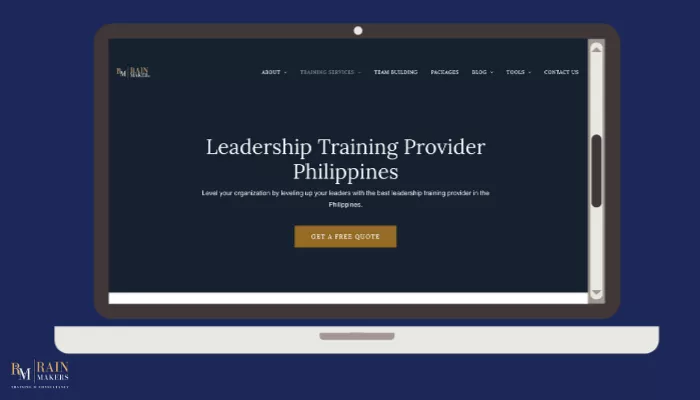
Rainmakers Training and Consultancy is recognized as one of the best leadership training providers in the Philippines, founded by the top Filipino leadership speaker, Venchito Tampon. The company focuses on equipping leaders (managers and supervisors) with practical skills for today's fast-changing business landscape. Their programs emphasize Leading Gen Z and Millennials, Basic Leadership and Management, and Leadership in the Digital Age.
Their flagship program, Modern-Day Leadership: Leading in the New Reality, helps leaders navigate the challenges of hybrid teams, generational differences, and post-pandemic leadership demands. It combines mindset development with real-world tools for leading with clarity and purpose.
2. Inspire Leadership and Consultancy
Strengths: Executive Leadership, Advanced Leadership and Management
Headquartered in: Manila, Philippines
Founded by: Francis Kong
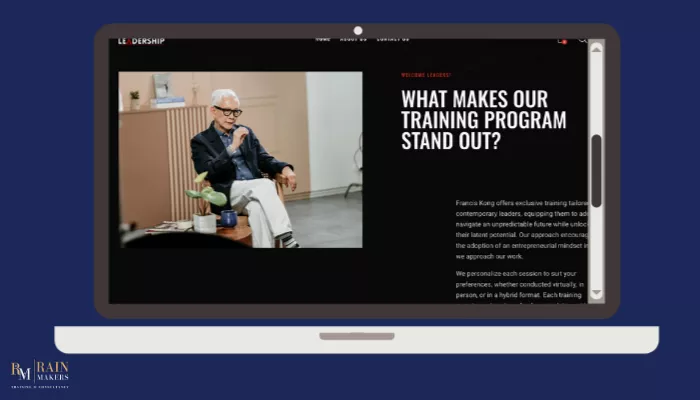
Inspire Leadership is known for its values-driven approach. The company specializes in programs focusing on Executive Leadership and Advanced Leadership and Management. Their sessions help leaders make ethical decisions, manage high-level responsibilities, and lead with vision and integrity across large organizations.
3. BusinessWorks Incorporated
Strengths: Change Leadership, Personal Leadership
Headquartered in: BGC Taguig, Philippines
Founded by: Anthony Pangilinan (Chief Disturber)
BusinessWorks offers training grounded in real-life experiences and behavioral change. They focus on Change Leadership and Personal Leadership, helping leaders navigate transformation, build resilience, and align personal values with organizational goals.
4. AIB Training
Strengths: Supervisory Leadership, Basic Management and Leadership,
Headquartered in: Bulacan, Philippines
Founded by: Ian Barcelona
With a strong presence in regional locations, AIB focuses on building core leadership capabilities in Supervisory Leadership and Basic Management and Leadership, making them a go-to provider for organizations outside Metro Manila.
How to Choose the Right Leadership Training Provider? [Checklist]
Having criteria when choosing the best leadership training provider in the Philippines helps you refine your choice and ultimately evaluate providers based on what matters most. Here are our recommended checklist when vetting leadership training providers:
1. Is the program customizable to your industry or company setup?
Your company or organization and your industry face unique challenges. So, a good leadership training program focuses on the specific realities of your industry, whether challenges, pain points, or trends. It also pertains to your company's specifics in connection with the industry: company culture, team dynamics, context, and business models.
A generic leadership training program may sound good in theory but will fail to address the learning needs of your training participants.
Identify the learning training objectives. With the help of the training provider or with your HR or OD team, invest the time to do a thorough training needs analysis to pinpoint exactly the needs of your employees.
These objectives will be the main basis of the training design and delivery of your chosen leadership training provider. The outline will meet the leadership objectives, while the delivery will connect with the participants' day-to-day experience.
Ask for proposal and training design, and look for signs that the training will use:
- Relevant industry examples (e.g., safety leadership in manufacturing or managing Gen Z in the workplace)
- Realistic role-play or case studies - built around your company's current issues, not random or vague scenarios
- Language and terms used by your team - build familiarity and make the lessons easier to absorb
Not customizing the content is one reason leadership training fails, so taking the time to ensure the trainer does it seriously ensures your investment will be worth your company's resources.
Here are a couple of questions to ask during your initial meeting with training providers:
- Do you conduct interviews or surveys before the training to understand our needs?
- Can you show a customized module you've created for another client in a similar industry?
- How do you make your content relevant to frontline managers vs. senior leaders?
Customization is already a standard for effective leadership training in the Philippines. So, do your due diligence to ensure that the training provider adapts to your team's reality.
2. Do the facilitators have actual leadership experience?
In the Philippines, many fly-by-night leadership speakers and trainers haven't led a single team or organization in their careers.
The best Filipino leadership speaker has led teams, handled pressure, and made real business decisions. All these will bring a deeper level of understanding and insights. It means they won't just teach concepts but actually share what works and what does not in real life.
Those leadership training facilitators who rely only on academic knowledge or scripted content deliver surface-level insights and generic advice, resulting in a leadership program where leaders may struggle to relate, especially when examples feel too idealistic or disconnected from daily operations.
The depth of expertise and experience of the leadership training speaker will largely contribute to his leadership training topics (you'll find that the module itself is hard-core to the actual challenges of current Filipino leaders).
Here are a couple of things you should look for in a leadership trainer:
- Past roles in leadership (entrepreneur, team leader, general manager, or senior executive)
- Experience handling real challenges (managing team conflicts, strategic planning, or handling organizational change)
- Ability to share deep practical insights (handling low-performing staff, coaching direct reports, and leading during a crisis).
When the leadership trainer is an actual practitioner (currently leading teams or organizations), you'll expect rich content, better facilitation, and content delivery.
3. Does the provider use active and engaging training methods?
One of the best ways to conduct leadership training is to design the program with activities that enhance the ability of training participants to think, reflect, decide, and act. For leadership skills to stick, participants must be actively involved in the learning process.
Slide shows, lectures, and long videos may look polished but don't lead to behavioral change. If learners only sit and listen, they will likely forget the content within days and return to old work habits.
The best leadership training programs use a mix of learning activities that drive engagement and reflection, including:
- Role plays and simulations
- Group discussions and peer sharing
- Self-assessments
- Case studies and decision decision-making challenges (frameworks in a realistic context)
- Action planning methods
Any of these methods will work for leadership training programs as long as they are aligned with the leadership training objectives and participants' needs.
4. Is there a clear way to measure training outcomes?
Like any investment, a company or organization investing in leadership training must have a return on investment (the cost of leadership training is not cheap at all).
Without clear measures, you'll unlikely know if the training has significantly improved your employees.
You can use Kirkpatrick's 4 Levels of Evaluation or other training evaluation tools to assess whether the training session has delivered tangible and intangible results.
You can follow the 4 Levels of Evaluation, which includes a mix of these assessments:
- Pre- and post-training assessments measure knowledge gain and behavioral change. Training assessments identify existing growth-focused and problem-focused learning gaps, while post-training evaluations show learning impact.
- Participant self-evaluations – to track their own progress and identify areas where they feel more confident or still need development
- Action plans and follow-ups to ensure participants commit to applying what they've learned and receive support to do so (follow-up or check-in sessions are becoming a common standard for leadership training to monitor progress or identify new learning needs).
- Quantifiable metrics (team performance, employee satisfaction, or retention rates) are challenging to measure but are possible when a series of leadership training programs are aligned to objectives (with set expectations and metrics to follow).
5. Are their training modules structured, updated, and aligned with current leadership trends?
The way we lead as Filipino leaders changes over time. Gone are the days when leadership was about authority and control, but more so, in today's time, the types of leadership are about autonomy, flexibility, and non-silo kind of management.
The best leadership training providers keep their modules current, structured, and aligned with the evolving needs of modern leaders, especially in fast-changing industries and digital workplaces.
For instance, you'll find many modules today that have adapted their insights from Simon Sinek, John Maxwell, Adam Grant, and James Clear, as well as top-rated learning organizations such as Gallup Workplaces.
By having these real-world practices from leadership experts, you'll find their leadership training programs to be strong and have the following components:
- Reflect current research, workplace trends, and leadership practices
- Include modern topics such as inclusive leadership, managing the Gen Z workforce, emotional intelligence, resilience, hybrid team management, and change management.
- Clear, organized frameworks to guide participants through a logical flow of learning
- Up-to-date case examples are drawn from recent business scenarios, not outdated references
Filipino leadership training today must require modern tools, updated insights, and practical structure. So, find a leadership training provider that truly reflects today's reality, not yesterday's textbook.
Need leadership training for your new and emerging leaders and seasoned managers? Book your free training needs analysis session.
Leadership Training Guide Philippines in 2025: Types, Programs, and Providers
Leadership training in the Philippines continues to grow as organizations invest in developing capable and future-ready leaders. Companies can now access a wide range of leadership development formats from structured programs and coaching to experiential learning and industry-specific training.
This guide covers the most common types of leadership training available in the Philippines and highlights the top Filipino leadership training providers helping shape the next generation of Filipino leaders.
What is Leadership Development?
Leadership development in the Philippines, also known as leadership training or management development, refers to structured efforts that build a person’s ability to lead individuals, teams, or entire organizations. It focuses on strengthening soft skills, such as communication, emotional intelligence, and decision-making, and strategic skills like goal-setting, delegation, and performance management.
Leadership development programs are designed to prepare professionals for greater responsibility, whether they are first-time supervisors, mid-level managers, or senior executives. These programs may include classroom training, workshops, coaching, mentoring, peer learning, or online courses.
Types of Leadership Training Programs in the Philippines
Leadership training in the Philippines is delivered in various formats to meet the diverse needs of professionals across industries. These programs aim to develop both foundational and advanced leadership skills, from managing oneself as a leader to driving organizational change.
Below is a breakdown of the most common and emerging types of leadership training available in the Philippines.
1. Formal Training Programs
Formal leadership training programs are structured learning sessions designed to build essential leadership knowledge, attitudes, and skills. They may be delivered through in-person workshops, online modules, blended learning formats, or classroom-based sessions.
The best leadership training provider often customizes these programs for different leadership levels, aspiring leaders, junior-level managers, mid-level managers, or senior executives.
Content for this type of program includes topics such as strategic thinking, performance management, conflict resolution, delegation, and employee engagement. Formal training will help you ensure consistency in learning across participants and often includes pre-assessments, post-training evaluations, and action plans for applying the lessons at work.
Many companies in the Philippines invest in formal leadership training as part of their talent development strategy.
The formal training program format is ideal for organizations that aim to structure their leadership capabilities with business goals, develop future-ready leaders, and promote a unified leadership culture.
2. Coaching and Mentoring
Coaching and mentoring provide personalized leadership development through one-on-one engagement with a coach, mentor, or senior leader. This leadership training format focuses on enhancing individual strength, addressing specific leadership challenges, and supporting career progression.
Coaching is often goal-oriented and time-bound. It involves a professional leadership coach guiding the leader through structured conversations that improve self-awareness, decision-making, emotional intelligence, and performance. One example is executive coaching, commonly used for senior managers or high-potential executive talent.
Conversely, mentoring is usually a longer-term relationship in which an experienced leader shares knowledge, provides feedback, and helps the mentee navigate leadership responsibilities. It's more informal but equally valuable for transferring wisdom and organizational insight.
Coaching and mentoring are gaining traction in the Philippines in multinational corporations and local companies. These approaches are often integrated into leadership development frameworks and succession planning programs, creating a safe space for reflection and time to build confidence and foster long-term professional growth.
3. Peer Coaching and Mentoring
Peer coaching and mentoring involve collaborative learning between individuals of similar rank or role. Unlike traditional coaching from a senior figure or external leadership coach, peer-based leadership development creates a space for mutual support, shared reflection, and real-time feedback.
This leadership training format helps leaders learn from each other's experiences, strengthen interpersonal connections, and build trust within teams or departments. Sessions may be structured with clear goals and check-ins or remain informal depending on the dynamics and the organization's setup.
Peer mentoring is also effective for new leaders who benefit from the guidance of colleagues who have recently transitioned into similar roles. It nurtures a culture of openness, empathy, and collective growth.
4. Action Learning
Action learning is a hands-on leadership development approach in which participants work in small groups to solve real and urgent business problems. This method combines learning with direct application, allowing leaders to develop critical skills such as problem-solving, collaboration, strategic thinking, and accountability.
This leadership approach is widely used in Philippine organizations that value individual and team effectiveness. It is especially relevant in fast-paced environments where leaders must make informed decisions, manage uncertainty, and take action under pressure.
Action learning helps leaders move beyond theory. Participants gain insights not just from the facilitator but most especially from peers facing similar challenges, which reinforces the idea that leadership is developed through experience, dialogue, and doing (not just instruction).
5. 360-Degree Feedback
360-degree feedback is a leadership development tool that collects performance insights from mutiple sources (managers, peers, subordinates, and sometimes external stakeholders like clients or suppliers). It fully explains a leader's behavior, communication style, interpersonal effectiveness, and leadership impact.
This leadership method is often used in the Philippines as part of leadership assessment and development programs. It helps leaders understand how others perceive them, uncover blind spots, and align their self-perception with external feedback. The feedback is typically anonymous, compiled into a report, and shared with a leadership coach or HR facilitator during a debriefing session.
360-degree feedback is not a performance appraisal but a tool for self-awareness and growth. It works best in cultures that promote openness, trust, and continuous improvement. When used effectively, it encourages reflection, strengthens emotional intelligence, and supports the creation of personalized leadership development plans.
Many Filipino companies use 360-degree feedback during leadership transitions, succession planning, or before launching leadership training programs, to ensure participants start their development journey with clear insight into their current leadership effectiveness.
6. Leadership Seminars
Leadership seminars are short, focused learning events that address specific leadership topics or emerging trends. They may last a few hours to a full day and are typically conducted in person, virtually, or in hybrid formats. See this guide to learn how leadership seminars are being conducted.
Unlike multi-session training programs, seminars are designed for quick learning and immediate application.
Topics often include adaptive leadership, leading through change, effective communication, innovation, team dynamics, or digital leadership. In the Philippines, leadership seminars are popular at conferences, industry events, and internal learning days organized by companies.
These seminars are often led by subject-matter experts, leadership speakers, thought leaders, or experienced practitioners who share frameworks, case studies, and real-world insights. The leadership training format encourages participants to interact through Q&A sessions, breakout discussions, or short workshops.
Leadership seminars are ideal for employees and entrepreneurs who need fast upskilling, exposure to new perspectives and insights, or reinforcement of existing knowledge. They are also effective for energizing teams, inspiring leaders to grow, aligning leaders on key themes, and introducing new leadership models.
7. Frontline Leadership Development
Frontline leadership development programs are designed for supervisors, team leaders, and first-time managers. These individuals often bridge upper management and the operational workforce, making their leadership role critical to daily performance and employee engagement.
In the Philippines, many companies offer one—to three-day programs focused on the core competencies needed to lead frontline teams. These include setting clear and measurable goals, monitoring team performance, managing tasks and resources, providing feedback, resolving conflicts, and inspiring team members to be self-motivated.
This leadership training format also covers interpersonal (social) skills such as empathy and assertive communication, which directly impact employee morale and productivity.
Frontline leadership development often includes case studies, role-playing, on-the-job applications, and coaching to ensure new leaders can immediately apply their learning. Some are even integrated into the onboarding process for new team leaders or offered as part of structured leadership pipelines.
When supervisors are equipped to lead effectively, organizations can benefit from reduced turnover, higher employee satisfaction, and more consistent goal execution. In the Philippine setting, where people management involves balancing authority with relationships, these leadership development programs help leaders gain the confidence and skills to lead competently and carefully.
8. Experiential Leadership
Experiential leadership programs are immersive training experiences that develop leadership skills through direct participation, not just theory. These leadership development programs use structured activities, such as simulations, games, field challenges, and scenario-based exercises, to help participants actually learn by doing.
The goal is reinforcing behaviors, decision-making mindset, and attitude in environments that mimic authentic leadership situations.
In the Philippines, experiential programs are widely used during leadership bootcamps, company offsite retreats, and transformational training sessions. Activities include:
- Leadership simulations involve participants managing a fictional crisis or leading a team through a complex task under time pressure.
- Outdoor challenges involve trust-building, collaboration, and uncertainty navigating, such as rope courses or survival-style team exercises.
- Business games that require participants to make decisions, manage resources, and compete as business units.
Each activity is followed by guided debriefing sessions, during which participants reflect on what happened, what leadership behaviors emerged, and how to apply those insights back at work.
Experiential learning is effective because it triggers emotional engagement, deepens self-awareness, and tests leadership under realistic stress. It helps participants move out of their comfort zone, experience leadership consequences firsthand, and develop agility, resilience, and team synergy.
In Filipino organizations, this leadership development approach works particularly well for mid-level managers, newly promoted supervisors, and cross-functional teams, especially when the goal is to break silos, shift mindsets, and build leadership presence beyond job titles.
9. Personal Leadership and Empowerment Workshops
Personal leadership and empowerment workshops focus on helping employees lead from within. These leadership development programs heavily emphasize self-awareness, values alignment, purpose, mindset, and emotional resilience, all influencing how leaders think, act, and inspire others.
In the Philippines, such workshops are increasingly popular among employees looking for management skills and deeper clarity on who they are as leaders. Sessions for this leadership training format often include guided reflections, visioning exercises, journaling, personal mission crafting, and group sharing. Participants are encouraged to examine their beliefs, motivations, and leadership identity.
Personal leadership and empowerment workshops may include leading purposefully, building inner confidence, managing limiting beliefs, and practicing mindfulness in leadership. These workshops are often used in values-driven organizations, social enterprises, NGOs, but not to exclude companies committed to holistic leadership development.
Unlike technical leadership programs, empowerment workshops aim to create authentic leaders who can influence through character and conviction. They help participants align personal goals with organizational roles and become more intentional in leading others. This approach is where it nurtures emotionally grounded, purpose-driven leaders capable of inspiring trust and long-term engagement.
10. Industry-Specific Leadership Training
Industry-specific leadership training is tailored to a particular sector's unique challenges, standards, and leadership demands. Unlike general leadership programs, these are customized to reflect the environment, culture, pace, and technical requirements of the industry where the leader operates.
In the Philippines, industry-specific leadership training is widely used in industries such as BPO, retail, healthcare, banking, manufacturing, logistics, and hospitality. Each sector faces distinct pressures, such as tight performance metrics in BPOs, frontline service leadership in retail, compliance and patient care in healthcare, or process-driven leadership in manufacturing.
Industry-specific leadership training programs are designed to equip leaders with both soft skills and sector-relevant strategies. For example:
- Retail leaders learn about managing high customer volume, team motivation during peak hours, and real-time decision-making.
- BPO leaders focus on coaching for performance, handling metrics, managing virtual teams, and maintaining engagement across shifts.
- Healthcare leaders are trained on empathetic communication, regulatory compliance, and managing multidisciplinary teams.
- Manufacturing leaders focus on lean leadership, safety compliance, process control, and shift supervision.
Industry-specific leadership training can help your leaders apply what they learn in their work context. It also helps organizations build competent leadership pipelines aligned with their operational realities.
11. Leadership Bootcamps
Leadership boot camps are intensive, short-duration programs designed to accelerate leadership development in a focused, high-energy setting. Typically lasting one to five days, these boot camps condense multiple leadership topics and activities into a compact schedule, making them ideal for fast-tracking emerging leaders or re-energizing experienced ones.
In the Philippines, leadership bootcamps are used by corporations, NGOs, and educational institutions to build leadership capacity quickly, especially in fast-paced industries such as sales, startups, BPO, and retail. These programs would combine various training methods, such as:
- Skill-building workshops
- Interactive discussions and case studies
- Group challenges and simulations
- Peer learning and feedback
- Self-assessment tools and action planning
The curriculum usually includes essential leadership themes such as personal leadership, team engagement, problem-solving, and accountability. Given this boot camp format, the emphasis is much more on practical application, agility, and reflection rather than solely on passive learning.
In the Philippine work culture, where camaraderie and group energy drive engagement, the boot camp experience fosters bonding while encouraging individual growth.
What sets boot camps apart is their intensity and immersion. They challenge participants to think fast, lead actively, and reflect deeply within a compressed timeframe. By the end of the program, leadership participants walk away with new knowledge, personal insights, confidence, and a clearer leadership voice.
12. Online Leadership Academies
Online leadership academies offer flexible, accessible, structured leadership training through digital platforms. These programs are ideal for employees and entrepreneurs who want to develop leadership skills at their own pace or companies with remote teams and nationwide operations.
Online academies have become more prevalent in the Philippines due to the rise of hybrid work and the growing need for scalable leadership development. International institutions, independent local training providers, or corporate leadership platforms often deliver these academies. Formats for online leadership academies include:
- Self-paced courses with video lessons, readings, and quizzes
- Live virtual classes with expert facilitators and group discussions
- Cohort-based programs where participants progress through modules together
- Blended learning that combines online modules with in-person or virtual coaching
Courses typically cover a range of leadership topics, from fundamentals like communication, delegation, and feedback to advanced areas such as change leadership, innovation, and strategic thinking. Leadership programs may also include certification upon completion, adding value to a professional's career profile (e.g., LinkedIn credentials).
Examples of these widely used platforms include Harvard edX, Coursera, LinkedIn Learning, and local leadership training providers such as Rainmakers Training and Consultancy, which offers a Filipino business context and language.
Online leadership academies are cost-effective, time-efficient, and scalable, making them ideal for companies that train large groups or leaders in different locations. For Filipino professionals, they provide access to world-class leadership education while offering the flexibility to learn amid busy schedules.
13. Internal Leadership Academies
Internal leadership academies are company-designed programs that develop leaders within the organization. These academies are tailored to reflect the company's culture, values, leadership model, and business strategy. Unlike external training providers, internal academies ensure alignment between leadership development and organizational goals.
In the Philippines, many large corporations, conglomerates, and progressive SMES establish their own internal leadership academies as part of long-term talent development and succession planning. These programs are structured into levels, often beginning with emerging leaders, followed by mid-level managers, and culminating in executive leadership modules.
Key features of internal leadership academies include:
- Custom curriculum based on company-specific competencies and scenarios
- In-house facilitators or executives serving as mentors and coaches
- Cross-functional projects to encourage collaboration and real-world application
- Performance-linked learning, where training outcomes tie to business results
- Blended method, including workshops, coaching, online modules, and action learning
These academies often run year-round and may include nomination-based enrollment, making them exclusive and aspirational. The talent development or OD team identifies these high-potential employees, nurtures internal mobility, and builds leadership pipelines that understand and embody the company's mission.
In the Philippines, internal academies also serve as a powerful retention tool. Employees feel valued and appreciated when their leadership growth is supported internally, strengthening loyalty and long-term engagement. This approach creates a strong internal leadership brand, leaders who are capable, culturally fit, aligned, and deeply committed to the organization's success.
Leadership Training Providers in the Philippines
In the Philippines, several reputable organizations specialize in leadership training, offering programs tailored to various professional needs. Here are some notable leadership training providers:
1. Rainmakers Training and Consultancy
Rainmakers Training and Consultancy is the top leadership training provider in the Philippines. Their flagship offering, Modern-Day Leadership: Leading in the New Reality, is designed to equip leaders with essential skills to navigate today's dynamic business environment. Rainmakers' approach integrates these pillars to develop adaptable, empathetic, and effective leaders in driving organizational success. Their programs are tailored to address leaders' unique challenges in the modern business landscape.
2. Inspire Leadership Consultancy
Inspire Leadership Consultancy is dedicated to inspiring personal, professional, and social excellence through its leadership programs. They provide in-house training, keynote speaking, public seminars, and team-building activities. Their programs are designed to unlock leadership potential and foster growth among individuals and teams.
3. Success Options Inc. by Francis Kong
Renowned speaker and entrepreneur Francis Kong offers the "Level Up Leadership" program to equip contemporary leaders with skills to navigate an unpredictable future. The program focuses on unlocking latent potential and adopting an entrepreneurial mindset. Sessions are personalized and can be conducted virtually, in person, or a hybrid format.
4. Asian Institute of Management (AIM)
Established in 1968 in partnership with Harvard Business School, the Asian Institute of Management (AIM) is a premier graduate school in the Philippines. AIM offers various leadership development programs through its Washington SyCip Graduate School of Business and the Stephen Zuellig Graduate School of Development Management. These programs are designed to equip leaders with the skills necessary for effective public and private management.
5. Development Academy of the Philippines (DAP)
Founded in 1973, the Development Academy of the Philippines (DAP) is a government-owned institution that provides training, research, and technical assistance to enhance the capacities of leaders in the public and private sectors. DAP offers programs focused on public policy, governance, and productivity to foster excellence and integrity among Filipino leaders.
6. Circa Logica Group
Circa Logica Group is a Philippine-based corporate training provider specializing in management, leadership, sales, and customer service development. They offer customized in-house training and public seminars tailored to the Philippine business environment, emphasizing practical application and relevance. Their programs combine theoretical knowledge with skills application exercises and action planning templates to enhance organizational capabilities.
How Would You Describe An Ideal Supervisor?
How would you describe an ideal supervisor?
If you've been asked this question in a job interview or a formal discussion about leadership, you probably reflect on the essential qualities of a supervisor and how you can, by any chance, shape the culture in your organization within your sphere of influence.
An ideal supervisor is more than just a manager who assigns tasks and calls it a day—they are leaders who guide, support, and empower their team.
Key Qualities of an Ideal Supervisor
An ideal supervisor balances his subordinates' well-being and top management's strategic initiatives. Doing so allows him to be a healthy leader without sacrificing the company's performance. A couple of essential qualities that define an exceptional supervisor:
Strong Communication Skills
One key role of a supervisor is communication: communicating responsibilities, strategies, concerns, and feedback to subordinates.
Practicing and mastering effective communication enables you to inspire your team through a healthy culture (relationships) and help them perform optimally (results).
To build the identity of a communicating supervisor, practice these actionable behaviors:
Practice active listening.
Focus on the speaker, ask clarifying and follow-up questions, nod to show interest, and summarize key points to show you understand their answers.
Encourage open feedback.
Ask employees regularly for their thoughts on tasks, processes, performance, organizational strategy, and workplace culture. While they may not have all the answers, they can give you input to inspire improvement in your daily work as a supervisor.
Use clear and concise language.
Avoid confusing words, use less jargon (if unnecessary), and always be direct when explaining tasks, expectations, and company goals. Value your subordinates' working time as you value yours.
Adapt your communication style.
You should adjust your communication style based on the individual's personality, experience level, knowledge of tasks, and preferred method (verbal, written, or visual).
Conduct regular team meetings.
Hold structured but interactive meetings to align on goals, discuss roadblocks, and celebrate wins to build momentum.
Give immediate and constructive feedback.
Address issues as they arise to avoid delays and future big fires—be a more positive and solution-oriented supervisor.
Master nonverbal communication.
Maintain eye contact, use open body language, and strengthen your relationship by asking, "What's in it for them?" (referring to the interests of the person you're talking to).
Clarify expectations in writing.
Send follow-up verbal instructions using emails, task lists, or memos to ensure project alignment and hold your people accountable for their goals.
Encourage two-way communication.
Enable employees to voice their opinions, contribute ideas, and ask questions freely—promote more psychological safety in your team.
Handle difficult conversations professionally.
Conflicts are necessary, so stay calm, focus on the facts (be more objective), and address concerns with wisdom and discernment while maintaining respect.
Use storytelling to inspire.
Be a leader who is vulnerable enough to share real-life experiences and stories. This will make conversation lighter and help you connect deeper with your subordinates. Always connect emotionally with your team.
Provide communication training opportunities.
Encourage employees to invest in personal growth by attending in-house workshops and corporate training programs, such as technical or soft skills training.
Fair and Consistent Leadership
Being a supervisor means leading by example. Being fair and consistent strengthens the core of your leadership by building the trust of your subordinates, making your leadership more stable.
A fair supervisor will ensure that his employees feel valued, have equal opportunities based on their skillsets (in other words, no special treatment), and are held to the same standards.
Here are actionable steps to develop fair and consistent leadership:
Set clear and objective performance standards.
Define measurable performance expectations based on your company's top-line strategy and ensure your team members apply them all to the best of their abilities (of course, there's no 100% perfect).
Make decisions based on facts, not personal preferences.
Use objective criteria when assigning projects or tasks or even when resolving disputes. The ECTEA model framework, which I shared in my problem-solving and decision-making guide, can help you set criteria for your teams.
Hold everyone to the same standards.
Apply policies, deadlines, and disciplinary actions (if necessary) consistently to all employees you manage, regardless of their tenure or level of relationships with you.
Recognize and reward based on merit.
This is relatively easy if you work for a multinational corporation with strict KPI guidelines. Otherwise, you would develop a transparent system for acknowledging achievements and ensuring that rewards are earned relatively.
Seek multiple perspectives before making decisions.
Decision-making is a core area of a supervisor's role. So, always consult with higher-ups, people you can mentor and trust for advice, and your team members for input so that you can make wise, sound, balanced, and strategic decisions.
Encourage an open-door policy for concerns.
This has become a trend in the workplace for years, given that top managers and C-suite leaders want their employees to voice their issues without fear of retaliation. The more they share their challenges, the easier for the company to put out fires before they get big. This also helps in innovating new ideas to improve the company's operations.
Regularly assess your own biases.
Reflect on your personal leadership decisions. Ask yourself if you're unconsciously favoring or overlooking certain employees. Being more self-aware helps avoid misunderstandings about your treatment and makes the team more confident in following you as their supervisor.
Document key decisions and policies. Keep records of feedback inputs, performance reviews, promotion notes, and disciplinary actions so you have documented files when needed, which helps ensure consistency and avoid misunderstandings.
Provide equal growth opportunities.
Do your best to provide your team members with the necessary training, mentorship, and career advancement opportunities. Allow them to see great potential in themselves as they continuously invest their time and other resources in their personal development.
Communicate changes in policies
Internal documents, including workplace rules, schedules, and expectations, would constantly change. Make sure everyone on your team receives the same information, and let them ask questions to clarify anything.
Encourage team collaboration and peer recognition.
Foster an environment where your employees recognize each other's contributions, helping to reduce any perception of favoritism. You can use the Five Languages of Appreciation in the Workplace by Gary Chapman to help you appreciate people for their work based on how they want to be appreciated (their language of appreciation).
Stay accountable to your team.
Ask employees for feedback on your leadership—becoming vulnerable makes you more credible as a supervisor. You need to grow in your leadership using data from feedback and make adjustments when necessary.
Rainmakers: The Leading Choice for Corporate Training
Do you need supervisory training program for your employees? Fill out our contact form to get a free quote today.
9 Best Leadership Training Topics (Most-Requested)
You’re now part of talent development, ready to launch leadership training for your new and seasoned employees. What you need the most is the best leadership training topics to discuss in corporate training.
In this guide, I’ll discuss the key leadership training topics that build essential skills. Whether leading a small team or a large organization with thousands of employees, you must hone and nurture specific skills to produce better outcomes and long-term success.
1. Adaptability and Resilience
In the age of AI and technology, leaders are facing a strong wave of innovation that a person with adaptability and resilience can stay effective during change and uncertainty.
These skills alone can help them endure and handle crises (which we have experienced so far during the COVID-19 season). They can also help their team members recover from setbacks by leading by example.
Key Competencies and KSA Requirements
1. Building a Change-Ready Culture
Knowledge: Organizational change principles, change management theories
Skills: Communication, change facilitation, employee engagement
Attitude: Openness to change, flexibility, proactive mindset
Insights: Change management, in general, is an advanced skill in leadership training for managers and supervisors. If leaders are trained with the fundamentals of leadership and management, and they’ve been demonstrating behaviors and skills as more than the above leaders, change management is the next level they should consider advancing in terms of competence.
2. Fostering a Growth Mindset
Knowledge: Principles of neuroplasticity, continuous learning models
Skills: Encouraging feedback, challenging fixed beliefs, personal development
Attitude: Positive outlook, willingness to learn, perseverance
Insights: Changing mindsets in leadership training requires specific activities that encourage self-reflection instead of lecture-based learning. Industry professionals can learn more from reflecting on and discussing events with other participants. As a corporate leadership trainer, this has been my go-to learning structure for fostering a growth mindset in leaders.
3. Identifying Opportunities and Threats
Knowledge: SWOT analysis, risk assessment methods
Skills: Critical thinking, strategic planning, scenario analysis
Attitude: Risk-awareness, forward-thinking, adaptability
Insights: SWOT analysis is a good way to spot opportunities and threats in your current role, team, and department. This is typically done before the year starts. However, you shouldn’t limit the exercise to just leadership training proper. You can also integrate it into your monthly or weekly tasks, as it can help you be more aware of your strengths and weaknesses - truly upskilling yourself.
4. Recovering from Setbacks
Knowledge: Resilience frameworks, coping mechanisms
Skills: Emotional regulation, stress management, problem-solving
Attitude: Perseverance, confidence, optimism
Insights: In previous leadership training programs, topics like recovering from setbacks were not commonly seen. Today, it has become a core topic of leadership training, and we even have a standalone training for this skill area. The reason is that a considerable number of professionals are still recovering from their losses (and potentially having mental health issues) that need to be addressed so they can be more equipped to face present and future challenges.
2. Change Management
As mentioned earlier, change management is an advanced skill for leaders. As a corporate trainer, I see it as a core corporate training program initially suited for mid-level, top-level, and suite-level managers. However, a couple of years later, it became part of the training development curriculum for aspiring and new managers.
The primary reason is that change management applies to superiors at the top and leaders who are still part of the front-line team, facing challenges at work head-on. If they know how to solve problems, it could have a significant impact upwards, and it can help drive innovation by bringing creative ideas that only front-line managers can think of.
Key Competencies and KSA Requirements
1. Understanding Change Processes
Knowledge: ADKAR model, Kotter’s 8-Step Change Model
Skills: Planning, communication, execution
Attitude: Patience, adaptability, resilience
Insights: I’ve had good change management training for strategy managers in one of the top outsourcing companies in the Philippines. It was a great experience learning directly from strategy managers who experience drastic changes inside and outside the organization (technology adaption, tools, strategies, etc..). They crafted their own change management process from my given framework, and a good couple of hours discussing their real-life examples of changes allowed them to increase their self-awareness and individually create their action plans to tackle them.
2. Managing Resistance to Change
Knowledge: Psychological reactions to change, stakeholder management
Skills: Negotiation, conflict resolution, persuasion
Attitude: Empathy, persistence, strategic thinking
Insights: The ADKAR and Kotter’s 8-Step Change Model are the best frameworks for change management. They’ve been tested and practiced across different organizations and industries, giving you the confidence that it works and would impact your target participants similarly.
3. Developing Employee Career Paths
Knowledge: Talent development strategies, mentorship techniques
Skills: Coaching, career mapping, performance assessment
Attitude: Supportiveness, vision-oriented thinking, encouragement
Insights: This competence addresses the human resource (human capital, as others refer to it) or any department involved in talent development. Change management today also includes drafting and implementing a solid career map for employees. It upskill HR leaders to consider the changes in job roles as changes arise in the organization.
3. Coaching and Mentoring
Coaching and mentoring have become a buzzword today. Still, I see few companies invested in leadership development (most companies with this as a core topic for leadership training are multi-national companies, but still very few).
Coaching and mentoring are essential skills in driving individual work performance. Leaders can help their direct reports see themselves as performers and address performance gap issues.
Key Competencies and KSA Requirements
1. Active Listening
Knowledge: Listening techniques, barriers to effective listening
Skills: Paraphrasing, asking clarifying questions, non-verbal cues
Attitude: Patience, attentiveness, empathy
Insights: Active listening isn’t just a particular behavior but a skill that leaders should constantly practice and master to improve. To encourage participants to practice this skill, you should design the training program to include workshops that enhance active listening. You should also probably share additional principles and points on mastering active listening.
2. Feedback and Reflection
Knowledge: Feedback models (e.g., SBI, GROW)
Skills: Constructive criticism, performance evaluation, goal setting
Attitude: Objectivity, encouragement, continuous improvement
Insights: Giving feedback is one of the leadership conversations that can help leaders’ subordinates improve their day-to-day work. Opportunities are spotted to put strengths into practice and identify gaps at work—in terms of knowledge, skills, and behavior- and improve each to increase the level of competencies.
4. Conflict Resolution
Conflicts are part of handling teams. As you transition teams from forming (the first stage of team development) to norming (the second stage), you’ll experience and see actual conflicts between team members that either challenge them to grow or could be a barrier to team harmony and productivity.
Knowing how to handle disputes effectively can help your team grow and function better.
Key Competencies and KSA Requirements
1. Identifying Sources of Conflict
Knowledge: Workplace conflict types, conflict resolution models
Skills: Root cause analysis, mediation, active listening
Attitude: Fairness, open-mindedness, emotional control
Insights: It’s a separate fundamental skill to know the root cause of the conflict. And it is easier said than done because you must figure it out honestly and critically during discussions and open forums.
2. Mediation Skills
Knowledge: Interest-based negotiation, neutral facilitation techniques
Skills: Compromise strategies, impartial listening, persuasion
Attitude: Neutrality, respect, solution-driven mindset
Insights: Your goal as a leader is not to be one-sided. You aim to unite parties involved using active listening skills and specific values such as respect and neutrality. The higher you go up the corporate ladder, the more challenging it is to manage subordinates’ disputes.
5. Effective Communication
All leaders are communicators. It is only a matter of whether the communication has a positive or negative impact. If you can persuade people with words and actions through effective communication, you can inspire them to achieve individual and team goals.
Key Competencies and KSA Requirements
1. Verbal and Non-Verbal Communication
Knowledge: Communication models, body language interpretation
Skills: Public speaking, storytelling, engaging presentations
Attitude: Confidence, approachability, authenticity
Insights: Most of how you show it is what your subordinates pick up as the message of your communication. This includes your tone of voice, speed, dynamics, and body language that you may not be consciously aware of as you speak but highly dictates how your team members perceive your message.
2. Active Listening
Knowledge: Barriers to effective listening, techniques for engagement
Skills: Summarizing, clarifying, showing empathy
Attitude: Open-mindedness, patience, attentiveness
Insights: Active listening is an essential element in leadership communication. By listening to them right away, you understand better the intent behind every word they say. This impacts your response to every situation and allows you to garner and build more trust with your team members.
6. Emotional Intelligence
Emotional intelligence has become a core module for many corporate training programs. Not only is it necessary for anyone to manage their emotions, but it’s also apparent that people are sensitive to other people’s emotions—a crucial area in strengthening work relationships.
Key Competencies and KSA Requirements
1. Self-awareness and Self-Regulation
Knowledge: Emotional intelligence models, mindfulness techniques
Skills: Emotional control, stress management, decision-making
Attitude: Reflectiveness, calmness, adaptability
2. Empathy and Social Awareness
Knowledge: Cross-cultural communication, emotional recognition
Skills: Perspective-taking, conflict resolution, inclusivity
Attitude: Compassion, fairness, open-mindedness
3. Relationship Management
Knowledge: DEI principles, interpersonal dynamics
Skills: Building trust, managing teams, networking
Attitude: Empathy, inclusivity, approachability
Insights: These three components of emotional intelligence—self-awareness, empathy, and relationship management are areas where one can master and strengthen competencies. I see these three pillars in most emotional intelligence frameworks, including Daniel Goleman’s Four Domains of Emotional Intelligence.
7. Problem-Solving and Decision-Making
We face problems and make decisions every single day at work. Leaders who know how to develop the best possible solution for every problem will have higher chances of getting promoted and achieving the organization's best performance.
Problem-solving and decision-making training can elevate your leaders’ critical and creative thinking skills, making them more competent and confident at work.
Key Competencies and KSA Requirements
1. Critical Thinking
Knowledge: Logical reasoning, bias recognition
Skills: Evaluating evidence, analyzing data, root-cause analysis
Attitude: Skepticism, curiosity, patience
2. Decision-Making Frameworks
Knowledge: SWOT analysis, cost-benefit analysis
Skills: Risk assessment, prioritization, scenario planning
Attitude: Confidence, responsibility, ethical considerations
Insights: In my problem-solving decision-making training, I teach the framework of SAPADAPPA, which is a PSDM tool to help leaders come up with the best solutions by first analyzing their situation, getting to the root cause of their problems, identifying the probable reasons and coming up with the best solution using the decision analysis.
8. Team Building and Collaboration
While there are many team-building facilitators, it is also true that leaders must know how to build their teams, not necessarily have them play different activities. But beyond just playing games, it is more about leaders intentionally developing their teams.
Key Competencies and KSA Requirements
1. Trust and Psychological Safety
Knowledge: Team dynamics, trust-building techniques
Skills: Transparency, delegation, recognition
Attitude: Honesty, openness, inclusivity
Insights: Psychological safety is a keynote talk or panel discussion topic in many HR and talent development seminars. The entire premise revolves around creating a healthy culture where employees are more open to their ideas, concerns, and challenges, which is a strong indicator of such a culture.
2. Effective Collaboration
Knowledge: Group problem-solving models, facilitation techniques
Skills: Conflict resolution, role assignment, active participation
Attitude: Cooperation, commitment, mutual respectf
9. Time Management
Effective time management helps leaders allocate their resources properly—where the most expensive resource every leader should manage is their time.
Leaders are not only individual contributors but also invest time in coaching and supporting their subordinates, learning to achieve maximum productivity while maintaining healthy relationships with the team members. These are crucial in today’s working environment.
Key Competencies and KSA Requirements
1. Prioritization and Planning
Knowledge: Time management frameworks (Eisenhower Matrix, Pomodoro Technique)
Skills: Scheduling, goal setting, workload distribution
Attitude: Discipline, consistency, self-motivation
2. Reducing Distractions and Increasing Focus
Knowledge: Productivity techniques, cognitive load management
Skills: Task batching, setting boundaries, focus improvement
Attitude: Commitment, awareness, persistence
How to Determine Leadership Training Topics?
1. Conduct a Training Needs Analysis
A Training Needs Analysis (TNA) identifies gaps in leadership competencies. A structured assessment evaluates employees' current skills, knowledge, and attitudes.
You can check out our Free Training Needs Analysis Template.
2. Identify Problem and Growth Gaps
As you go deeper with your training needs analysis, you’ll find both problem and growth gaps in the competencies of your subordinates. This is where you need to analyze them so you can design a training program (or outsource it to the best corporate training provider in the Philippines - if you lack the resources to do so).
What’s the difference between the two: problem gaps and growth gaps?
Problem Gaps: These indicate a deficiency in key leadership competency, such as ineffective communication.
Growth Gaps: These focus on continuous development, ensuring employees refine their skills without pressing issues.
3. Design and Align Training with Business Goals
All leadership training must support organizational objectives (aligned leadership training objectives). It doesn’t stand alone like another statistic or schedule in the training calendar.
Leadership training programs are investments in the company's people, so it’s critically important to make them worthwhile in terms of costs and time.
4. Ask for Recommendations From SMEs or Trainers
You can hire a training design consultant if you lack the technical knowledge or expertise to identify your employees' training needs. These consultants specialize in analyzing and designing aspects of a corporate training program (end-to-end), giving you everything you need to create a successful training event.
5. Use Proven Frameworks
If you want to do it yourself, you can go directly to widespread and successful leadership training frameworks for the above leadership competencies
- Change Management: ADKAR Model
- Communication: DISC Model
- Emotional Intelligence: Goleman’s EQ Model
- Decision-Making: SWOT & Cost-Benefit Analysis
If you’re looking for an engaging leadership training program that meets your training needs and business objectives, contact us today for a free quote.
Unconscious Competence: Mastery Beyond Awareness
Unconscious competence, the final stage in the four levels of competence, represents the pinnacle of skill development.
At this stage, individuals perform tasks effortlessly and flawlessly without conscious thought. This level marks true mastery and sets itself apart from the earlier stages by its seamless and automatic execution of skills.
As a multi-industry entrepreneur, corporate trainer, and speaker, I aim to attain mastery through constant practice and effort in my career. Imagine performing tasks that feel effortless, as if you’ve been doing them for years and decades already—this makes unconscious competence worthy of learning about.
In this guide, we will explore unconscious competence and how it differs from the other levels of competence.
We will also discuss its applications in corporate training, leadership development, and enhancing workplace culture, focusing on developing soft skills.
Understanding the Four Levels of Competence
The Four Levels of Competence model is a framework for understanding how individuals acquire and develop skills. It consists of:
- Unconscious Incompetence: The individual does not know what they do not know.
- Conscious Incompetence: The individual recognizes their lack of knowledge or skill and begins to understand the need for learning.
- Conscious Competence: The individual can perform the skill, but requires effort and deliberate thought.
- Unconscious Competence: The individual performs the skill effortlessly, with mastery so ingrained that it feels natural.
While the earlier stages involve awareness and effort, unconscious competence is distinct because it is automatic and fluid. It signifies the internalization of skills to the point where they no longer require active mental engagement.
What Sets Unconscious Competence Apart
Unconscious competence is unique in several ways:
- Effortless Execution: Tasks are performed instinctively. For example, an experienced driver navigates traffic without consciously thinking about every gear shift or turn.
- Efficiency: Energy and mental resources are conserved, allowing the individual to focus on other tasks or challenges.
- Intuition: Decisions are made based on ingrained expertise rather than conscious analysis, which can accelerate problem-solving in dynamic situations.
- Transferability: Skills at this level often translate to related areas, broadening an individual’s capability.
This level of mastery is essential in areas that require split-second decisions or multitasking, such as leadership roles, problem-solving and decision-making, creative industries, and technical professions.
The Path to Unconscious Competence
Reaching unconscious competence is a progression that depends on consistent practice, feedback, and refinement. It is not merely about repetition but about deliberate practice, where individuals continuously challenge themselves to improve.
Key factors include:
- Deliberate Practice: Focused repetition with attention to improving weaknesses.
- Feedback Loops: Constructive criticism to fine-tune performance.
- Time and Experience: Gradual improvement over an extended period.
Unconscious competence requires a solid foundation built during earlier stages of learning. Most people skip the first three levels, making them vulnerable to not mastering the fourth level. You must create a solid foundation of the three levels to progress well in the fourth.
Individuals cannot transition into this effortless mastery without conscious competence, where deliberate thought and effort are applied.
Applications of Unconscious Competence in Corporate Training
Unconscious competence plays a critical role in corporate environments. Organizations aim to embed this expertise within their workforce to foster efficiency, adaptability, and innovation.
1. Enhancing Corporate Culture
A corporate culture that values unconscious competence emphasizes training and mentorship. It promotes:
- Skill Automation: Employees excel in their roles without excessive micromanagement.
- Peer Learning: Seasoned employees such as managers, supervisors, and directors serve as role models, demonstrating the ease and mastery of unconscious competence. We call this “leading by example.”
- Increased Collaboration: Teams with unconscious competence in soft skills, such as technical writing, communication, and empathy, work more harmoniously.
2. Leadership Development
Leadership requires a blend of technical knowledge and interpersonal skills. For leaders, unconscious competence means:
- Decisive Action: Making decisions quickly based on experience rather than analysis paralysis.
- Visionary Thinking: Leaders with mastered skills can focus on strategic goals instead of routine tasks.
- Role Modeling: Leaders demonstrate the mastery that inspires their teams.
Programs to develop leadership skills should emphasize transitioning participants to unconscious competence in areas like communication, conflict resolution, and decision-making. Learn why leadership training fails, invest in the best programs (and discover leadership training costs).
Here are a couple of actionable guides we wrote about leadership:
Building Soft Skills Through Unconscious Competence
Soft skills like communication, empathy, and teamwork are often undervalued in skill-building frameworks but are essential for workplace success. Achieving unconscious competence in soft skills transforms workplace interactions:
- Effective Communication: Individuals communicate clearly and adaptively without consciously strategizing.
- Emotional Intelligence: Empathy becomes second nature, enhancing relationships and reducing conflicts.
- Team Synergy: Teams function more cohesively when members have mastered collaboration and conflict resolution skills.
Corporate training programs must include consistent practice scenarios, role-playing, and feedback loops to ensure soft skills move beyond conscious competence.
Best Practices for Corporate Training
To foster unconscious competence, corporate training must be structured to support continuous learning and real-world application:
- Simulation-Based Training: Realistic scenarios enable employees to practice skills in a controlled environment.
- Microlearning Modules: Bite-sized, repetitive lessons ensure retention without overwhelming learners.
- Mentorship Programs: Experienced professionals guide less experienced employees, providing insights that accelerate mastery.
- Regular Assessments: Feedback mechanisms track progress and identify areas needing improvement.
By combining these approaches, organizations can help employees internalize skills, fostering unconscious competence at all workforce levels.
Challenges in Reaching Unconscious Competence
Despite its benefits, achieving unconscious competence can be challenging. Common obstacles include:
- Complacency: Individuals may plateau, thinking they have mastered a skill prematurely.
- Overconfidence: Without regular reassessment, unconscious competence can lead to errors if the environment changes.
- Skill Decay: Without ongoing practice, mastery can diminish over time.
Organizations must counter these challenges by encouraging lifelong learning and promoting adaptability.
The Role of Technology in Facilitating Unconscious Competence
Technological tools have become instrumental in helping individuals reach unconscious competence. Examples include:
- AI-Based Feedback Tools: Provide instant analysis and recommendations for improvement.
- Gamified Learning Platforms: Motivate learners to practice consistently through rewards and challenges.
- Virtual Reality (VR) Training: Immersive experiences replicate real-world scenarios, accelerating skill internalization.
By integrating these technologies, businesses can enhance the effectiveness of their training programs.
Mastering Skills Beyond Awareness: The Key to Sustainable Success
Unconscious competence is the ultimate goal of skill development, where mastery becomes second nature. It sets itself apart from other stages of the competence model through its effortless execution and efficiency. For organizations, cultivating unconscious competence within their workforce is essential for building a thriving corporate culture, effective leadership, and cohesive teams.
Organizations can help individuals achieve unconscious competence through structured training programs, consistent practice, and technological support. This will create a more capable and confident workforce, enhance performance, and contribute to long-term success in any professional environment.
70 20 10 Rule: How to Optimize It for Learning and Development
The 70-20-10 rule is a widely fundamental framework in learning and development (L&D). It is also the basis of my learning structure when I design corporate training programs and packages for our clients.
This rule defines the optimal mix of learning and sources for effective professional growth, especially for managers and leaders. It was developed in the 1980s by Morgan McCall, Michael M. Lombardo, and Robert A. Eichinger at the Center for Creative Leadership.
In this guide, we’ll explore the 70-20-10 model, its components, and my practical insights on applying this for leadership development, with real-life examples so that you can visualize it yourself.
What Is the 70-20-10 Rule?
The 70-20-10 rule suggests that learning happens in three ways:
- 70% through experiential learning (on-the-job experiences)
- 20% through social learning (interactions with others)
- 10% through formal learning (structured courses and training)
While in real-life scenarios, you’ll find variations of this percentage, to be honest, but the principle remains the same. Not every learning and development comes from simply attending courses and training programs. Most active learning happens in on-the-job experiences and through coaching and mentoring (which has become a trend in talent development today).
The Three Components of the 70-20-10 Rule
70% Experiential Learning
Experiential learning focuses on learning by doing. It involves tackling real-life challenges, solving problems, and applying skills directly in the workplace. Employees apply what they have learned from formal and informal education to tackle daily work challenges in this type of learning.
Experiential learning is the most significant contributor to growth because it allows individuals to learn in a context relevant to their roles. Instead of simply acquiring knowledge, they learn, unlearn, and relearn by doing the task. Their knowledge is tested when they encounter obstacles to accomplishing it so they can find efficient and better ways to solve problems.
One of the best examples of experiential learning is leadership development. It covers these initiatives and skills assessments to learn and grow from work experiences.
Project Ownership: A manager leads a cross-functional team to execute a new initiative, learning project management and team dynamics. By having autonomy on the subject, the employee can own the decisions and outcomes arising from every task accomplished.
If you are a leader, one way to ensure your subordinates learn from their work is to inculcate project ownership. The more they make decisions and achieve wins, the more they want to accomplish.
Problem-Solving: For example, addressing workplace conflicts teaches communication and decision-making.
Most conflicts cannot be solved simply by attending a problem-solving and conflict-management seminar. However, it would help if the corporate trainer smoothly transitioned the session to discuss issues within teams openly.
In reality, this doesn’t happen in most cases. Conflicts get burned in the ground, which causes malfunctions in relationships, resulting in more miscommunication and inefficiency.
Stretch Assignments: For instance, a marketing professional might take on a sales role, gaining new insights and broadening their skill set.
Experiential learning becomes more apparent in new roles and projects. Since the newly trained professional doesn’t have practical experience with the new task, it makes sense that they would make more mistakes than in previous work/tasks/projects.
The coaching and mentoring hat (20% social learning) must be worn here. If the leader becomes more of a coach or mentor than a boss, the need for further refinement of skills that can only be achieved through constant practice will be better understood.
There are a couple more examples, but you should now understand how critical 70% of experiential learning is to learning and development.
20% Social Learning
Social learning happens through interaction and collaboration; for leaders, it refers to coaching and mentoring.
Through daily work interactions and professional relationships, it becomes simpler for professionals to gain knowledge and practical experience from others’ expertise and experiences.
To give you context, in leadership development, someone in a mentorship program looks like this: a junior manager learns leadership skills by shadowing a senior executive. Through actual observation of the real work, the junior manager understands the nuances and challenges of the new task.
Even during lunch breaks, the junior manager can learn additional information from his superior, further expanding his work knowledge.
A feedback culture is an example of social learning applied to leadership development. Team members provide constructive feedback during reviews, enabling individual growth.
Giving feedback can be formal or informal, as nowadays, most professionals are busy with their daily activities. Sometimes, it doesn’t fit into their schedules to have as frequent feedback sessions as it used to be.
You’ll find many managers giving feedback after an actual task. For instance, a sales manager giving direct feedback right after a presentation of his sales presentation with a prospective client. That feedback is more effective as the timing is right after a task is delivered, and more often than not, it is more retainable in the professional’s mind.
Topping it off as part of social learning in leadership development can help employees see improvement through the eyes of their peers, whether feedback from the same department or other departments.
Sharing best practices regarding what works in the company can be a good source of social learning. It is relevant to the employees' work and adds more value to the overall KPIs of the team or department being assessed.
10% Formal Learning
We couldn’t ignore the remaining 10% as it often matters.
Formal learning refers to structured training programs, workshops, or e-learning courses. While it contributes the least in percentage, it provides foundational knowledge that can be applied in practice.
When employees join a company, they typically undergo morning sessions to gain fundamental knowledge about their work, team, department, and company. This gives them a foundational understanding of why they do what they do and how they perform at work.
In the leadership development context we mentioned earlier, formal learning could be anything in corporate training, such as attending a leadership training workshop to learn about emotional intelligence, completing an online course on conflict resolution techniques, or simply participating in seminars on emerging industry trends.
All these can add to the employee's formal learning, which can further develop as they apply all these to their work. It’s about application, as we say and know.
Many multinational companies in the Philippines offer their employees a series of modules and structured formal learning. Conversely, startups have difficulty doing this, as they focus more on their operations and often neglect their talent development. In this case, outsourcing to the top corporate training providers is a more viable option.
How to Implement the 70-20-10 Model?
This section warrants a new post, as there are many things to do when implementing the 70-20-10 rule in learning and development. As such, giving you a start, this list gives you more actionable tips than any other guide on this subject.
1. Make Experiential Learning the Core (70%)
This applies to any company size, industry, and revenue. All employees need a solid experiential learning culture where they can see themselves growing inside the company. As most Gen Z will constantly reiterate during their interviews, this is essential for finding personal and professional growth in their companies.
Here are some tips to make experiential learning part of your systems in your talent development:
- Assign employees challenging projects that align with business goals to develop hands-on problem-solving skills.
- Rotate employees through different roles or departments to broaden their skill sets and perspectives.
- Incorporate on-the-job training for real-time learning in high-impact scenarios.
2. Foster Social Learning Opportunities (20%)
This tip is easier said than done, as it depends mainly on the team and company's culture and how the management manifests and leads by example in ensuring employees capitalize on learning opportunities.
Best practices in fostering social learning opportunities include:
- Pair employees with mentors to provide guidance and real-world insights.
- Host regular peer-learning forums or cross-department workshops to share knowledge.
- Encourage feedback loops during team meetings to integrate learning into daily operations.
3. Deliver High-Impact Formal Training (10%)
This is what Rainmakers, as a corporate training provider, specializes in. We deliver high-impact corporate training programs to clients of different sizes in teams, organizational structure, and training needs.
Whether you want to do it in-house or outsource, corporate training programs must have any of these - you can do as action plans for your teams as well:
- Create short, targeted workshops or online modules addressing specific competency gaps.
- Tailor learning materials to align with immediate organizational priorities and goals.
- Integrate post-training follow-ups to connect concepts to workplace practices.
You can check out our guides on how to conduct leadership training, its cost and pricing models, and the best leadership training programs in the Philippines.
4. Blend the Learning Methods
You won’t often find a single learning method in practice. So, blending all these methods and rules will be helpful in many of the observations for learning and development.
Few tips on how to do it:
- Start with structured training and apply new skills in workplace challenges (70%).
- Reinforce training outcomes by assigning mentors or facilitating group discussions (20%).
- Encourage employees to document and share key takeaways from their experiential learning.
5. Continuously Monitor and Adjust
You can only ensure the effectiveness of an activity if you measure it so you can continuously adjust for more improvements. Here are some things you can do to adjust the learning initiatives:
- Track progress using measurable outcomes like skill improvements or project success rates.
- Collect feedback from participants and mentors to refine learning approaches.
- Regularly evaluate the alignment of learning initiatives with business goals to ensure
Optimize Learning and Development
We are at an age where not learning is costly for companies and individuals. Using the rule we have - 70-20-10 and other fundamentals and trends in learning and development helps us better optimize our learning and development interventions in companies.
Organizations can create programs that drive measurable results by focusing on experiential, social, and formal learning in the proper proportions. Strengthening the synergy between these components ensures maximum impact, helping individuals and teams grow effectively.
Adopting the 70-20-10 model requires intentionality and commitment. However, proper implementation can transform how organizations approach employee development, paving the way for long-term success.
How to Conduct Leadership Training: Step-by-Step Guide For Effective Design and Delivery
Leadership training is a cornerstone of talent development in many organizations. The more equipped leaders are, the better the organization's future and ability to sustain success.
Many organizations' leadership training programs are attractive to younger workforce generations, especially Gen Z, who prioritize career growth and skill development (based on Deloitte Global 2024 Gen Z and Millennial Survey).
Truthfully, leadership training is essential for talent recruitment and retention, so every L&D and HR practitioner must know how to implement the programs effectively.
In this guide, I’ll walk you through how to conduct leadership training and even share some of my experiences as a corporate trainer facilitating results-oriented leadership training programs.
How to Conduct Leadership Training?
1. Secure Top Management and Stakeholder Support
Any success of leadership training programs begins with buy-in from top management and key stakeholders.
While this shouldn’t be at the top of the conservative list when conducting leadership training, I find it a bottleneck for many HR practitioners as they move to the next phase of training—delivery. They could design the training program well enough, but they would find it difficult to ask participants to attend the training if it is not fully supported by key stakeholders right at the start.
Before anything else, create a business case or proposal and present it to top management and key stakeholders. Share your plans and clearly communicate the benefits of the leadership program, including its potential impact on employee work, performance, retention rates, and organizational growth.
You may include case studies and data reports to build the credibility of your proposal. It is best if you can find available data that’s locally contextualized here in the Philippines.
If you are a learning and development manager, you can establish a steering committee to oversee the training initiative, from requests for training budgets to the evaluation of the leadership training program.
2. Conduct a Training Needs Analysis
By identifying gaps in leadership competencies, you’ll have a solid benchmark of where to start your leadership training. This will also be the basis of your training evaluation if you can close any leadership competency gaps.
Competency gaps could be either problem-focused or growth-focused. Problem-focused competency gaps refer to any problems in the knowledge, skills, and attitude of your leaders that need to be addressed; otherwise, they would be detrimental and, worse, could affect the culture of the team and organization.
Conversely, growth-based gaps refer to potential improvement in the competencies—including specific KSA (knowledge, skills, and attitude of your leaders)—that you want your participants to level up with.
You can check out this guide on how to do training needs analysis.
Here are a few TNA gathering methods:
- Focus group discussions (FGD)
- Interviews with key beneficiaries
- Job materials and work documents
- Surveys and questionnaires
- Feedback systems
- Incident reports and problem logs
These are just a few, but they can help you start gathering more information about your leadership training needs.
3. Prepare a Proposal and Budget
Prepare a TNA plan and proposal after conducting a training needs analysis. The document should outline the program’s objectives, expected outcomes, and financial requirements.
Not only will it help you secure funding, but it will also provide a guide for management and stakeholders to understand the process of your leadership training.
Here’s what to include in the proposal:
- Training objectives and alignment with business goals.
- Target audience and selection criteria.
- Detailed cost estimates (e.g., trainer fees, materials, venue, food, etc..).
- A timeline for development and delivery.
Budgeting is critical—factor in all possible expenses and present a cost-benefit analysis to demonstrate ROI. This is where you need to research the available options for conducting a leadership training program: doing it in-house with your trainer or hiring a corporate training provider to facilitate and deliver the program.
You may want to check out this guide on how much leadership training costs in the Philippines.
Now, this goes to our next step:
4. Decide Between In-house or Outsourced Training
There are many upsides and drawbacks to conducting leadership training programs or outsourcing to a corporate training provider.
Doing it in-house is less costly and can foster and develop an internal learning culture, as participants are challenged to learn from each session conducted by internal trainers.
I find this effective for multinational companies with more than 100 employees. In this particular case, they simply hire in-house trainers who specialize in competencies such as leadership and are accredited in many local and global certifications to be credible enough to do facilitation in-house. It is a different story if you’re working in a startup or SME, as it doesn’t have this type of leverage.
Outsourced training is ideal for accessing expert trainers who can deliver leadership training at the highest level. Given that these trainers have conducted the same program multiple times and can customize it based on the context of the organization and its participants, you’ll see a much better outcome from their training.
Another overlooked advantage of outsourcing leadership training is getting fresh perspectives outside your organization. Typically, when learning revolves around each company employee, there is a tendency for limited learning. If you hire an external leadership trainer, you can acquire new insights and best practices on specific leadership competencies that could elevate the skills of your target participants.
These insights may include patterns that the corporate trainer assesses in his career of training different sets of clients—thus allowing him to see which strategy, tool, or tip actually works for a certain industry.
Another thing: the best upside for getting outside trainers is the training content itself—you wouldn’t simply access it if you conducted leadership training in-house. Either you attend public seminars offered by the preferred corporate training provider or hire them exclusively—both options can give you access to the trainer's premium content.
Assuming you’re doing it in-house as you want the leadership training program to be cost-effective, here are some actionable tips for effective leadership training program design:
- Incorporate interactive elements like real-time surveys (e.g., Mentimeter), simulations, role-playing, and case studies contextualized to your industry or organization.
- Add modules on relevant topics such as leadership communication, diversity and inclusion, culture building, and digital transformation.
- Tailor content to different leadership levels, from emerging leaders to senior managers. It could be a series of leadership courses or coupled with individual coaching sessions for each participant.
5. Implement the Leadership Training Program
If you outsource leadership training, the corporate trainer will 70 to 90% implement the leadership training program.
But of course, there are a few things you should do to assist them in ensuring they’ll perfectly implement the training program. Not considering these can likely cause leadership training to fail.
Things you should assist corporate trainers with include:
- Preparing the training venue beforehand (ensure you book it if it’s outside your office vicinities, e.g., hotel function room).
- Ask the corporate trainer if any materials are needed (e.g., Manila paper, flipcharts, whiteboard, etc.).
- Be hospitable to your corporate training company. Make them feel you want to partner for a successful leadership training event.
For internal (no outsourced) leadership training, you can use various teaching methods to cater to the different learning styles of your target participants. Effective methods are:
- Workshops: Encourage active participation and group discussions.
- Role-Playing: Help participants practice real-world scenarios in a safe environment.
- Case Studies: Analyze real-life challenges to develop problem-solving skills.
- Blended Learning: Combine in-person sessions with online modules for flexibility.
Your implementation phase of the training program highly depends on the availability and level of your participants. So be sure to identify them even during the TNA process.
6. Evaluate the Effectiveness of Leadership Training
The only way to measure whether the leadership training impacts your target beneficiaries and the organization is to have it evaluated. Training evaluation is crucial for identifying areas for improvement.
Here’s a structured approach based on Kirkpatrick’s Four Levels of Evaluation to help assess your leadership training program. It covers:
- Reaction: Collect participant feedback on the training experience. You can use post-training feedback or evaluation forms.
- Learning: Test knowledge acquisition through quizzes or assessments.
- Behavior: Observe changes in workplace performance (e.g. performance reviews).
- Results: Measure the training’s impact on business metrics like employee engagement and productivity (i.e. ROI analysis to assess financial benefits versus costs).
Based on evaluation results, refine the program for future iterations to ensure continuous improvement. This can also help you strategize whether to retain the outsourced corporate training provider or hire a different one to customize your team's programs better.
Invest In Your Future Leaders
Leadership training is a strategic investment in your workforce and organization. By following these structured steps—securing management support, analyzing needs, preparing a solid proposal, choosing the right program, implementing effectively, and evaluating outcomes—you can create a training initiative that fosters strong leaders, drives engagement, and aligns with business objectives.
This approach meets the demands of today’s workforce and positions your organization for long-term success.
Best Leadership Training Programs in the Philippines in 2025 (Reviewed)
You’re probably an HR practitioner, event organizer, and in-house learning and development officer looking for ways to improve your people through leadership courses.
Let me give you five of the best leadership training programs in the Philippines, some of which I’ve personally attended (Venchito speaking), and you can attest to the level of content and insights you’ll get from them.
I’ve shared my best insights and what I think the leadership program is for.
Best Leadership Training Programs in the Philippines
1. Modern-Day Leadership Training Program By Rainmakers
I know it’s weird to take this on top of the list of leadership training programs in the Philippines. But I highly believe in our own leadership training course.
Some of our recent clients include companies such as Ordermo.ph, Ibarra Events and Catering, Cocolife, Lingaro, Emmronn, Maroon Studios and SM Leisure Resorts. These brands hired me (Venchito) to conduct a comprehensive leadership training program for their leaders at different levels in their organizations.
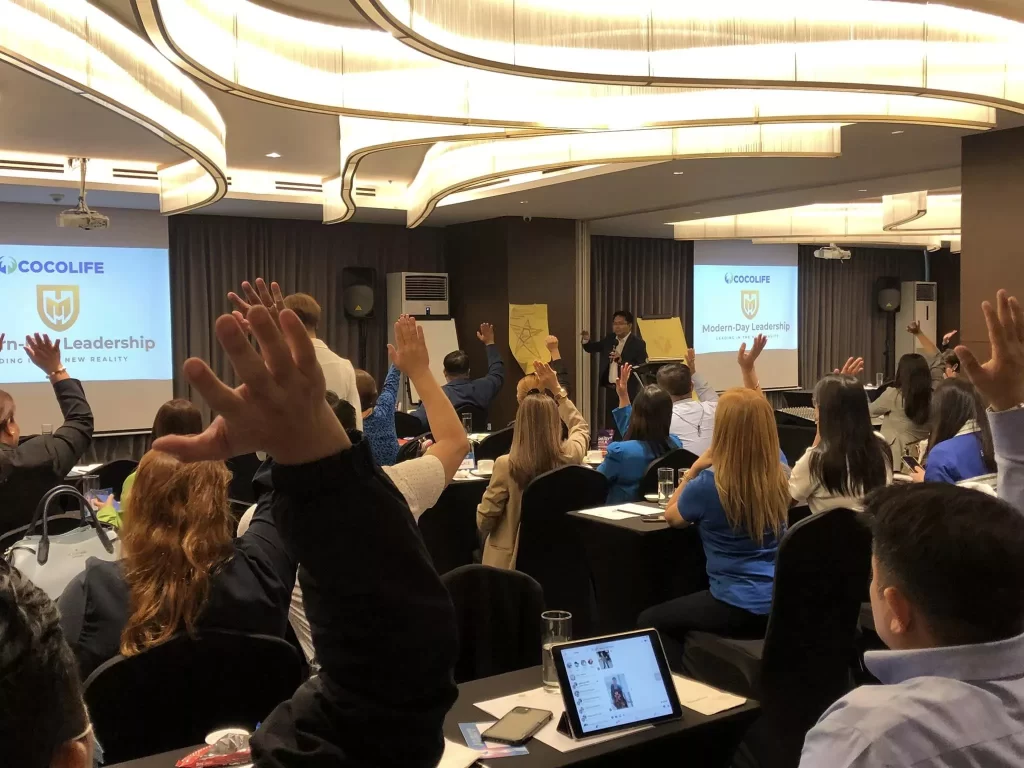
Modern-Day Leadership Training program is designed for managers, supervisors, soon-to-be-promoted leaders, and executives to upgrade their skills and attitude in learning their people.
With the new workforce (Gen Zs), this leadership program aims to give you upgraded and relevant information on the challenges leaders face today, including multi-generational communication issues.
By focusing on these five pillars (see image below), we can help you develop the right leadership style centered on values that can guide your team toward getting results for your company or organization.

These five pillars include:
- Modeling – Lead by Example
- Connecting – Lead by Heart
- Visioneering – Lead with Direction
- Empowering – Lead in Trust
- Modeling – Lead through Collaboration
Previous clients who requested this topic from Venchito include:

What makes the Modern-Day Leadership Program different?
1. It is centered on values.
Other leadership programs may be focused on developing skills, which is greatly important in today’s changing business landscape. However, I still believe in building the proper foundation of character for leaders.
If leaders operate on their personal values, aligning them hopefully with the values of their organization, they can be more effective in handling people in such a way that they do more than what is required of them.
They cater to the needs of their people instead of only trying to satisfy their desires and needs.
2. It contains relevant information.
I loved books, but some of the leadership books may not be relevant to today’s leadership culture. Leadership trainers must continually upgrade their materials to be more relevant in how organizations develop their leaders.
With the rise of technology and automation, how can leaders adapt to employees’ ever-changing needs and changing business landscape?
You can see the relevance factor in corporate training materials when the Filipino corporate trainer provides real-life examples and case studies in the workplace. All these give insights that training participants can take home to their workplaces.
3. It guides participants to develop leadership habits.
Modern-Day Leadership Program gives you a framework for the habits you have to build as leaders and tools and strategies you can utilize in different leadership situations.
When you’re still starting as a leader and have been leading people for a while, there are specific leadership theories and principles you must adapt to that situation.
Habits will help you teach discipline in your leadership life. That said, with our leadership training program, you can experience how to build healthy habits to support your everyday leadership role.
Bring Modern-Day Leadership Program To Your Company
Invite Venchito Tampon and his team to conduct a Modern-Day Leadership Training program so you can upgrade the leadership skills of your employees and executives. Contact us to set an initial meeting and get a free quotation.
2. Level Up Leadership by Francis Kong
Considered the top-ranked speaker, trainer, and business consultant, Francis Kong’s best-selling training program has helped thousands of leaders from different organizations across different industries.
I (Venchito) personally attended his Level Up Leadership in 2019, and I would say I’m a recipient of the valuable lessons and insights from Mr. Francis Kong himself.
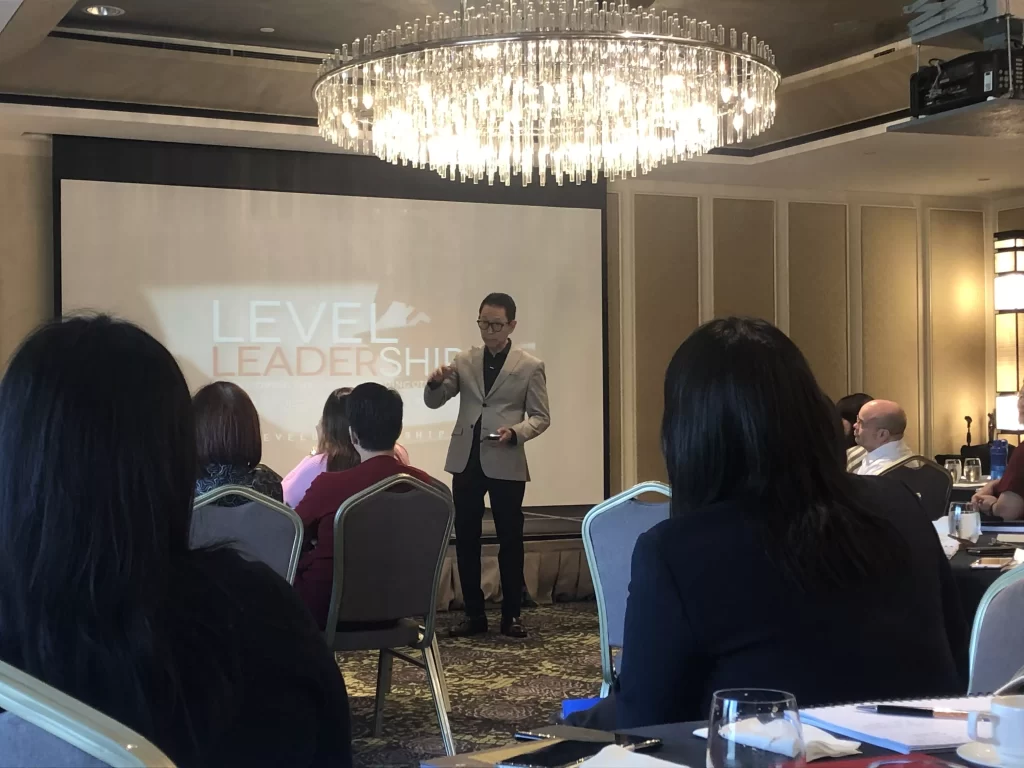
What I liked about Level Up Leadership?
- Leadership methodologies from different generations. Mr. Francis Kong will show you how leadership has evolved over 50 years from how Baby Boomers used leadership as a tool to manage their business to where it is today, working with the Generation Z workforce.
- It is centered on values. Though Mr. Kong will show you the exemplary leadership skills to pursue, including how to ask relevant questions and engage your people, you won’t miss topics about values and character development.
- The subject “servant leadership” is included in the program. As far as I remember, it is one of the last topics he discussed that shared how Jesus led his 12 disciples – which is the most impactful part of the program.
- Relevant case studies and group discussions. Mr. Francis wants his audience to engage with one another, which means group activities where sharing and discussion are highly encouraged. I loved this part because you’ll have plenty of time to network with like-minded individuals and learn how they apply leadership in their respective industries.

Who does Level Up Leadership cater to?
Intermediate to advanced-level leaders, i.e., executives, deans of schools and colleges, government officials, and high-level directors and managers. Most topics are advanced and well thought out towards a high-level knowledge. That said, the program is still excellent and applicable for newbie leaders.
3. Moving into Management by Boris Joaquin
This is another leadership training I attended in 2019.

Boris Joaquin is one of the premier leadership corporate trainers in the country. Having been sought by the top 1000 corporations and SME leaders, Boris knew how to conduct leadership training that could best serve his audience.
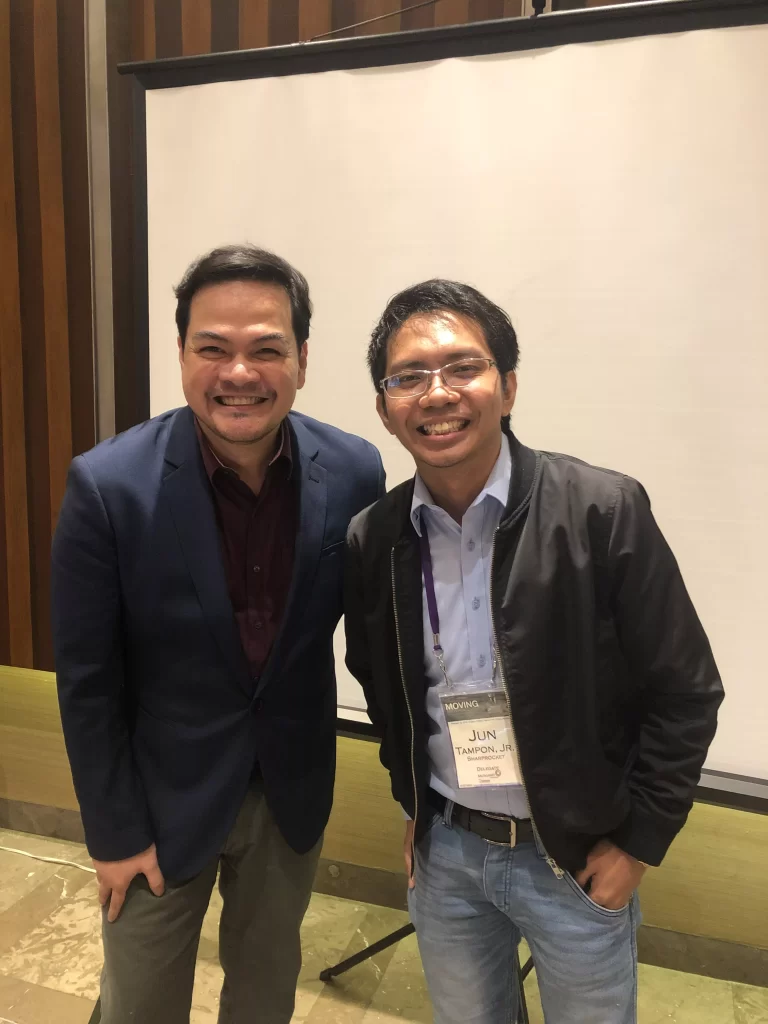
What I liked about Moving into Management?
- Easy to understand principles of management and leadership, i.e., the fundamental differences between management and leadership.
- Group activities to help you understand better yourself as leaders and how to apply specific topics to everyday living.
- Plenty of time to network with other corporate leaders.
- Fun and light environment. You would find yourself having fun while learning at the same time.
- Excellent workbook I can take home and get more insights from.
Who does Moving into Management cater to?
Moving into Management program is catered to rank-and-file employees or any position soon-to-be organization leaders. It is a preparatory training to help them understand what management and leadership is all about.
I believe this program isn’t for advanced-level leaders. However, some of the principles still apply to executives and directors in the company.
4. Step Back Leadership by Lloyd Luna
I haven’t attended any Step Back leadership program of Lloyd Luna. Yet, based on the videos and stories he posted, I can attest that his leadership program has truly helped many leaders in different organizations.
What I liked about Step Back Leadership
- Step Back Leadership is rooted in how ancient leaders lead their people and conduct succession planning programs.
- Local context. You would find the difference between how local leaders and Western counterparts lead their organizations. There is a significant difference; you would understand the principles behind how we are wired to be led.
- Simple to understand. You can have this leadership program for every level of employee – rank-and-file, managers, supervisors, and executives.
5. John Maxwell Leadership Trainings
Certified John Maxwell Trainers, including Ardy Abello, Anthony Pangilinan, and Mondo Castro, also brought Western leadership programs here.
Needless to say, Dr. John Maxwell is considered the world’s leadership expert who has written hundreds of books on leadership and success.
This is a testament to his global impact and the value and quality of his leadership programs.
What I liked about John Maxwell’s Leadership Training:
- Timeless principles. John Maxwell is pretty good at creating laws for every topic, including communication, leadership, and success. These laws are evergreen and can be applied to every context, industry, organization, country, and age.
- Simplicity. You don’t have to be highly educated to understand his principles. Maxwell is pretty good at simplifying things and making it easy for you to apply in everyday life.
- Inspirational. Most Maxwell training programs and books have an element of inspiration in them. Even just reading his books, you’ll feel a sense of inspiration to take action and level up your leadership game.
Key Takeaways
That’s it. Those are leadership training programs in the Philippines, some I’ve personally attended and reviewed, so you know what to expect in the corporate training.
If you’re looking for a corporate trainer to level up your leaders, contact us for a free quote on our Modern-Day Leadership Program.
How Much Does Leadership Training Cost in the Philippines in 2025?
How Much Does Leadership Training Cost in the Philippines in 2025?
Leadership training prices Philippines can range from ₱10,000 to ₱1,500,000 per program. Entry-level sessions may cost as low as ₱10,000, while multi-day, highly customized programs for senior leaders can go up to ₱700,000. Costs vary based on program scope, duration, group size, and the level of customization required.
Factors That Affect the Cost of Leadership Training
The answer, “it depends,” to the question, how much does leadership training cost? may surprise you, but it is the reality when you hire a corporate training provider to conduct leadership training programs or when you want to do it in-house with your L&D practitioners.
Professional Expertise
The expertise and reputation of the trainer significantly affect pricing. A trainer with in-depth experience or popularity in their field will command higher rates. Corporate training providers like Success Options Inc., Inspire Leadership, all founded by Francis Kong, and LJMB (Learning Just Made Better) by Louie Banta are known for offering high-quality programs, which may come at a premium price.
In this regard, you should do some research and ask for proposals and quotations to determine the cost of each leadership training program.
Duration of Training
Another factor impacting the cost of leadership training is its duration. How long or short it is depends entirely on the training needs of your leaders and managers.
For instance, leadership training can change from a two-day session to a series of modules covering 10 key areas such as:
- Leadership Communication
- Coaching and Mentoring
- Decision-Making and Problem-Solving
- The POLC Framework (Planning, Organizing, Leading, and Controlling)
The longer the duration, the more costly the training, as it covers each leadership area in detail. This is much better for facilitating a great learning experience for your participants.
Beware of training providers who’d like to conduct one-hour leadership training. Leadership training usually lasts half a day to weeks.
Number of Participants
The standard participant size for training is 25 to 30 individuals. Larger groups might be split into batches, increasing overall costs. For instance, a company needing to train 100 employees might run four sessions, each with a unique price. So paying P70,000 for 1 batch of 25 pax for your 100 employees will cost you P280,000.
Mode of Training
Given that today's workforce consists of hybrid teams, leadership trainers adapt to this changing learning need. There are usually two types of training modes today: on-site training and virtual training (another is a combination of two—hybrid training).
On-Site Training: In-person training costs more due to venue fees, travel expenses, and logistical requirements. And if it’s outside the metro, like the venue to be held is somewhere in Subic or Boracay, the leadership training costs adjust to that.
Virtual Training: This is typically less expensive but may limit hands-on engagement. Hybrid options can also be explored to balance cost and effectiveness. In our leadership training, we experienced all three training modes, which highly depend on what the clients want and how the participants could better adapt to the program.
Company Budget and Resources
Another significant factor in leadership training cost, of course, is the company budget and resources. If you’re part of the HR team of a startup company, it may not have a big budget compared to multinationals (assuming the startup company isn’t funded by any investor—in this case, it is a bootstrapped company).
That’s not to say startups don’t invest in leadership training. In fact, we’ve seen many startups today encouraging their leaders to be trained with us—it’s a matter of the decision of the top management.
Leadership Training Pricing Models
There’s no one-size-fits-all price point for leadership training programs. Differences in training needs, target participants, and training goals produce a sizable number of pricing scenarios.
To give you a hint, leadership training programs can fall either any of these (or a combination) of these pricing models:
Course Model
You’ll see a course model option for multi-national companies' leadership development programs. Leadership training comprises three or ten modules, or even more, each focused on a specific area, such as emotional intelligence, leadership conversations, or management essentials.
The course model usually works for companies with different management levels (top management, middle management, and lower management). Given that each management level requires a different leadership training curriculum, a particular corporate trainer would create customized and personalized training modules for each of these levels.
Hourly Model
Trainers who charge on an hourly basis usually want to work on short-term projects with clients. These projects could last an hour or up to one whole day, and they would include coaching sessions for each participant for an immersive learning experience.
This is very rare for corporate trainers, given that they usually charge for a day's training, which goes to the last pricing model.
Daily Model
Training costs are calculated per day. Depending on the factors mentioned earlier, a two-day leadership session may cost Php100,000 to Php500,000. At Rainmakers, for example, we conduct 1 day to 2 days for our Modern-Day Leadership Training. This ensures we covered all essential topics and that activities and workshops were adequately included in the training.
How to Get Buy-In for Leadership Training Programs
If you’re an L&D or HR professional, convincing top management to invest in leadership training is crucial. It could be a make-or-break scenario, as this is where the leadership training program will depend. If you can persuade them to invest (if they’re still not into it), hiring a corporate training provider to conduct leadership training programs is much easier.
Here’s how to get more buy-in support for your leadership training:
Influence Key Stakeholders
Present a strong case for leadership development. Don’t just mention you’ll conduct one at a particular quarter or month.
Highlight its benefits for improving productivity, employee engagement, and business outcomes. Today, we’ve seen several case studies in which L&D practitioners can now justify training spent as long as it helps the company achieve its goals and objectives.
Your ability to influence your higher-ups is also a good indication of how much you truly want leadership training in your organization.
Emphasize ROI
The language of business is numbers. Emphasizing the potential return the organization can make once training has been implemented could strengthen your case when you present it to top management.
Of course, realistically speaking, you can’t quantify learning, but at least in the grand scheme of things, you can help improve the KSA of your leaders, knowledge, skills, and attitudes—which can all correspond to certain quantifiable outputs for your organization.
One way to support you with this is to use case studies or data from companies within your level and industry. This would help management better understand the investment and impact of leadership training programs.
Start Small
Begin with a two-day training for a select group of leaders. If you have over a hundred managers and supervisors, start with a few to help the management see its impact weeks and months after the training.
This pilot program for a few leaders can help demonstrate the value of leadership training to decision-makers. And the more you see results (assuming you get the best corporate trainer in the Philippines), the more opportunities you’ll have to conduct the same training for your other leaders.
Partner with Experts
Work with trusted providers like Rainmakers, who bring experience and expertise. It may sound self-promotion, but a well-known provider increases credibility and ensures high-quality training.
The typical process for conducting leadership training programs starts by proposing three or more service providers. Management will decide which one best fits the company based on context, industry experience, facilitators’ level of expertise, and other related factors.
Plan and Budget Strategically
Allocate a portion of the annual budget for leadership training during strategic planning sessions. If you’re not part of the top management, you have to influence them to set aside a budget for corporate training.
It is easier said than done, but the only way to fully implement training for your leaders is to have it approved by the top.
Realistically, it is not easy to get a seat on the board and relay your case as to how training can impact the company's bottom-line goals. Most organizations are still reluctant to do this and would rather invest in technology and other business functions except human capital.
In this case, your abilities and skills to influence them are much more required.
Sample Cost Breakdown
| Training Type | Cost (Php) | Details |
|---|---|---|
| Basic 2-Day Training | 50,000 – 200,000 | Includes core leadership skills |
| Advanced 5-Day Program | 300,000 – 800,000 | Covers leadership strategies and coaching |
| Modular Program (10 Modules) | 500,000 – 1,500,000 | Comprehensive leadership development |
| Virtual Training | 10,000 – 50,000 | Per session, fewer logistics required |
Develop Future-Ready Leaders
Leadership training is an investment in building future-ready leaders.
Organizations can maximize the benefits of these programs by understanding the factors affecting costs and aligning them with company goals.
Whether opting for a basic session or a multi-module program, choosing the right provider ensures a meaningful impact on employee performance and organizational growth.
With the tips mentioned above on how to get more buy-in and support from top management, you’re likely to start having the confidence, trust, and courage to execute leadership training for your company this year.
5 Levels of Leadership: John Maxwell's Framework
John Maxwell’s 5 Levels of Leadership outlines a clear pathway for leadership development.
I highly recommend this book as a leadership trainer, speaker, and business consultant.
In this guide, I’ll walk you through the five levels that define the growth and impact of every leader and organization. I'll also share my personal insights into how you can leverage them in Filipino leadership.
Level 1: Position
Leadership begins with a title or role. At this stage, people follow because they have to, not because they are inspired.
From the name itself, leadership relies on their authority to direct and guide others. So people follow them because of their position —that of a supervisor, manager, or director. It creates structure but the most basic level of influence.
Pro Tip: If you assess yourself in this position, you’ll have solid benchmark where to start. Determine ways to improve as a leader and better influence others.
Increase self-awareness and emotional intelligence. To be a great leader, you must understand that people follow you more than just the surface level—your job role. As soon as you understand it, you’ll grow into the next milestone of your leadership.
Level 2: Permission
Leadership progresses when connections form. The keyword here is relationships.
People follow because they want to. Trust and connection are key, as leaders earn influence by genuinely valuing others and fostering a positive team environment.
When your team members permit you to enter their professional lives, allowing you to serve as their mentor, coach, or advisor, it becomes easier to work with them and adjust to their working styles.
Have you noticed any bosses or managers who are always being left behind by their team, as if the team doesn’t want their boss around all the time? That speaks truthfully for leadership who are not in the second level—permission.
Permission allows you to get closer to your team. Given that high-performing teams require both results and relationships, it’s critically important to build professional connections with your team so you can get to know them better.
Pro Tip: Invest time in knowing your people. Learn the five languages of appreciation (framework by Gary Chapman) to identify what makes your people tick. From there, you can think of ways to connect with your people by valuing their work and them as human beings.
Level 3: Production
Results define this level.
People follow because the leader achieves tangible outcomes.
At this stage, leaders focus on team performance, driving productivity, and leading by example to inspire commitment and results.
Given that you’re a solid contributor to the team, organization, and even to your upper leaders, people see that you’re setting an example for them to work hard and smart to get the results.
At this leadership level, you help people produce the same or higher output so that the organization will be rewarded for your efforts.
Pro Tip: Learn how to transfer skills to your people through coaching and mentoring programs. Strategize how you can teach your team (not based on how you understand it), but more on how your team can learn from the knowledge and skills you’d like to transfer to them.
If you can identify gaps through training needs analysis, you’ll have a better understanding of the learning path and be able to execute coaching well enough, given that it comprises 70% of the 70-20-10 model in learning and development.
People learn much more in their jobs than they can acquire from formal training programs.
Level 4: People Development
Actual growth happens here. People follow because the leader invests in them.
This involves mentoring, coaching, and empowering others to become leaders themselves. At this level, leaders build a legacy by multiplying their impact.
People development is what leaders should aim for. More than the results you and your team produce, you’re much more concerned about how you can develop your team members.
In today’s work environment, the new workforce - Generation Z, is leaning towards personal and professional development. As they see themselves growing in the organization, it becomes a good reason for them to stay longer.
Pro Tip: Include people development in informal (casual) and formal interactions with your subordinates. As the team learns more about their daily work, you can advise, give feedback, or transfer knowledge.
As a consultant and corporate trainer, I challenge my participants to reach this level, as this is where true success starts. When they continuously develop themselves, the team will be more ready to adapt to the ever-changing needs of the market.
Level 5: Pinnacle
The highest level of leadership is earned through sustained excellence and integrity.
The reality is that it takes a long time for people to respect you as a leader. People follow you because of your values.
By seeing you as a great example of character and success, they would want to rally with you to achieve your professional goals and the goals of the organization. They’re no longer working just for the sake of earning money but for the true mission you carry as a leader.
Achieving the pinnacle is rare for corporate organizations, as most top leaders consider results to be their ultimate career goal.
However, genuinely successful leaders want to leave a legacy by developing their people and seeing them become better leaders in the future. Through servant leadership and other leadership types, they continuously invest in them, even sacrificing for them. They make the best efforts to see others grow through their example.
Pro Tip: Live by values and live a life of character and integrity. Pursue character development over anything else. Be true to yourself, as authenticity matters to being a pinnacle leader.
How to Move From One Leadership Level To The Next?
This framework provides clarity for leaders at any stage. Knowing how to level up from your current level helps you achieve your professional and personal goals.
1. Recognize your current leadership level.
Be self-aware. Check your current leadership level and be honest with yourself so you can create leadership objectives as soon as possible.
Without self-awareness and honesty, you won’t deal with the challenges accompanying your current leadership level.
If you’re at level 1 - position, start connecting with your people. If you’re at 2, be a person of results, not just as an individual contributor but as a holistic contributor to your team and organization. If you’re at level 3, learn to develop others through coaching and mentoring. If you’re at level 4, stick to your values and walk through it.
2. Take actionable steps to grow.
Develop yourself. Read books, attend seminars, and participate in in-house training programs that include soft skills training such as problem solving and decision-making, critical thinking, leadership communication, and management.
Do not rely solely on your organization's training. Learn to invest your hard-earned money to further improve your knowledge and skills.
As you grow, you’ll see yourself moving from one leadership level to the next.
3. Become a person of influence.
A person of influence doesn’t need to manipulate others through words or actions. Because of their character and personality, they can move others to take action.
Learn body language and how it affects when connecting to others. As you improve your body language, you’ll see yourself effortlessly persuading others to do your favor.
4. Produce results and inspire others.
Make work efficient and effective. Produce the desired output to improve most of your work. By doing so, you’ll be seen as an asset by your company and someone worthy of investing in.
Inspire others to do the same so your team members can achieve what you have achieved (and even more). Leaders cannot motivate others. They can only inspire others to be self-motivated.
Professionals have self-motivation; you just need to tap it to give them the push they need to create fantastic work.
5. Develop future leaders and create lasting impact.
Your goal is not to do all the work all the time. Your role as a leader is to delegate tasks and decisions so others feel empowered to do their own work.
Through autonomy and trust, you can produce leaders from being just followers. From here, you can create lasting impact-producing leaders who can also grow others.



